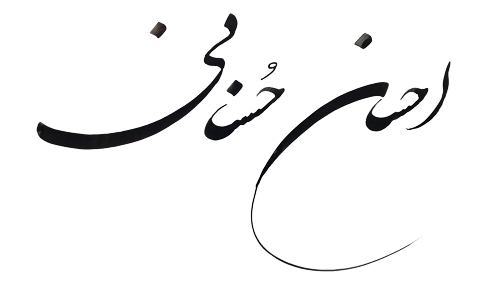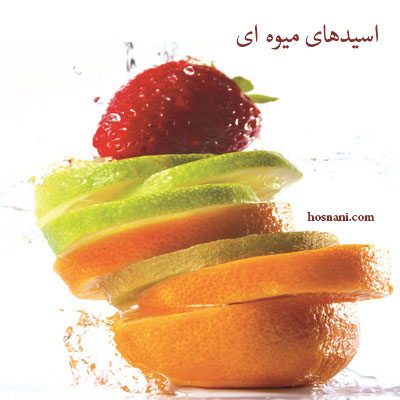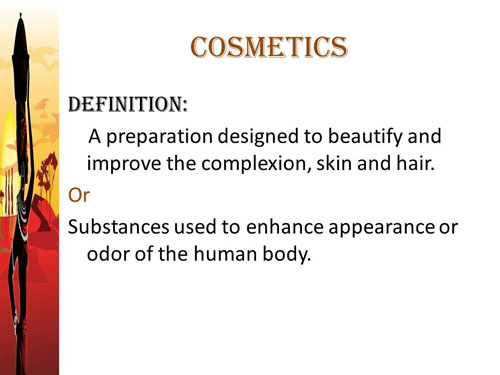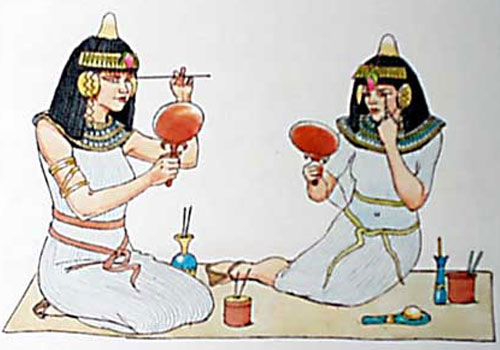کازمتیک = cosmetic
نویسنده:
چکیده: معادل انگلیسی کلمه یا واژه کازمتیک، Cosmetic می باشد.
کازمتیک چیست؟
کازمتیک = Cosmetic
cosmetic = در نقش صفت بدون s جمع: آرایشی بهداشتی (مثلا محصولات آرایشی بهداشتی)، زیبایی (مثلا جراحی های زیبایی)، ظاهری (مثلا تغییرات ظاهری)
In today’s image-conscious society, people are looking for an affordable cosmetic hair loss solution that delivers on its promises. This presents an opportunity for high performance, clinically proven anti-hair loss products. (Capixyl)
ARACHIDYL ALCOHOL — A fatty alcohol derived from coco- nuts, used as an emulsion stabilizer in cosmetic products. ARACHIDYL GLUCOSIDE — Obtained through the condensation of arachidyl alcohol, a fatty alcohol, and glucose. Used in cosmetic products as a surfactant and emulsifier. (INCI dictionary)
ASCORBIC ACID — Vitamin C. Powerful antioxidant and nutrient, very beneficial to the skin. Plays an essential role in building collagen, the connective tissue that makes up 70 percent of our skin. Vitamin C is also a natural preservative, protecting both the oil and water phases of cosmetics. Ascorbic acid is a water-soluble form of vitamin C. (See also Calcium ascorbate.) (INCI dictionary)
آسکوربيك اسيد يا ويتامين سي: آنتي اكسيدان و ماده مغذي قدرتمند است كه براي پوست مزاياي زيادي دارد. نقش اساسي در ساخت كلاژن دارد كه 70 درصد بافت هم بند پوست را تشكيل مي دهد. ويتامين سي همچنين يك ماده پرزرواتيو يا نگهدارنده طبيعي است كه فاز آبي و روغني محصولات آرايشي- بهداشتي را محافظت مي كند. آسکوربيك اسيد فرم قابل حل در آب ويتامين سي است. (به كلسيم آسكوربات نيز مراجعه شود)
BEHENYL ALCOHOL — A fatty alcohol derived from coconuts, used as an emulsion stabilizer in cosmetic products. (INCI dictionary)
BETA VULGARIS — Beet Root Extract. Rich in polysaccharides, this powerful humectant is clinically proven to boost the skin’s natural moisturizing factor, forming a film on the skin that actually locks moisture in for up to 8 hours. Phytonutrients enhance cell renewal and a high antioxidant content protects skin from free radical damage. The extract or juice of beets is also sometimes used as a natural red color in cosmetics. (INCI dictionary)
عصاره ريشه چغندر: غني از پلي ساكاريدها: ماده هيومكتانت يا جاذب الرطوبه قدرتمند كه به صورت كلينيكي اثبات شده كه مي تواند فاكتورهاي مرطوب كننده پوست را تقويت كند. لايه اي روي پوست تشكيل مي دهد كه رطوبت را براي 8 ساعت روي پوست نگه مي دارد. مواد مغذي موجود در چغندر نوسازي سلولي را افزايش داده و محتواي بالاي آنتي اكسيدان آن از پوست در برابر آسيب هاي ناشي از راديكال هاي آزاد محافظت مي كند. عصاره يا شيره چغندر گاهي به عنوان رنگ قرمز طبيعي در محصولات کازمتیک استفاده مي شود.
CELLULOSE GUM — The most abundant polymer found in nature. Used as a setting agent in hairsprays, styling gels and mousses. A natural alternative to synthetic polymers (such as PVP) found in most mass-produced styling aids. Also used as a binder and thickener in cosmetic products. (INCI dictionary)
CERA ALBA — Beeswax. A natural humectant, also used in cosmetics as an emulsifier and thickening agent. (INCI dictionary)
موم زنبور عسل: ماده هيومكتانت طبيعي كه در محصولات كازمتيك به عنوان امولسيون كننده و قوام دهنده استفاده مي شود.
CITRIC ACID — Extract from citrus fruits used as a natural pH adjuster in cosmetics.Added to shampoos, it acts as a chelating agent, binding to chlorine and iron (from hard water) and removing them from the hair. (INCI dictionary)
سيتريك اسيد: عصاره به دست آمده از ميوه هاي مركبات كه براي تنظيم pH به محصولات كازمتيك اضافه مي شود. از سيتريك اسيد در شامپو به عنوان شلات كننده براي اتصال كلر و آهن و خارج كردن آن از آب سخت استفاده مي شود. به اين ترتيب اين مواد روي موها رسوب نمي كند.
CITRUS MEDICA LIMONUM — Lemon Oil/Lemon Peel Oil. Essential oil with antioxidant and antibacterial properties, often used in cosmetics as a skin freshener and for its cool, pleasant fragrance. (INCI dictionary)
روغن پوست ليمو يا روغن ليمو: اسانس روغني با ويژگي هاي آنتي اكسيدان و ضدميكروبي. در صنعت كازمتيك به عنوان طراوت دهنده پوست استفاده مي شود. رايحه عطر ليمو خنك و لذت بخش است.
COCOS NUCIFERA OIL — Coconut Oil. Rich emollient exressed from coconuts. It is naturally converted into a soap through a saponification reaction with an alkaline salt. Beware of cosmetics that bill themselves as natural and use a synthetically processed derivative, sodium lauryl sulfate, claiming it comes from coconut oil. Accept nothing but the real thing in its natural form. (INCI dictionary)
روغن نارگيل: يك امولينت غني، استخراج شده از نارگيل. در فرايند صابوني سازي در حضور نمك هاي قليايي به صابون تبديل مي شود. برخي محصولات آرايشي- بهداشتي ادعا مي كنند كه طبيعي هستند و از مشتقات سنتزي مثل سديم لوريل سولفات استفاده مي كند. اما ادعا مي كند كه حاوي روغن نارگيل هستند. اگر دقت كرده باشيد در تبليغ بسياري از شامپوها گفته شده حاوي روغن نارگيل، در صورتي كه اينگونه نيست. روغن نارگيل اگرچه به عنوان ماده اوليه در فرايند ساخت سديم لوريل اتر سولفات ممكن است استفاده شود اما اين موضوع نمي تواند موجب شود كه استفاده كننده اين تركيب چنين ادعايي كند.
COPERNICIA CERIFERA — Carnauba Wax. Plant wax used as a thickening agent in cosmetics, and to increase the spreadability of powdered makeup for better coverage. (INCI dictionary)
واكس كارنوبا: واكس ياموم گياهي كه به عنوان قوام دهنده در محصولات آرايشي- بهداشتي (كازمتيك) استفاده مي شود تا قابليت پخش لوازم آرايشي پودري را افزايش داده و پوشش آنها را بهتر كند.
CORIANDRUM SATIVUM — Coriander Seed Oil. Antibacterial, often used in cosmetics for its spicy fragrance. (INCI dictionary)
روغن بذر گشنيز: ضدباكتري، به علت رايحه اسپايسي يا تندي كه دارد در صنعت كازمتيك استفاده مي شود.
CYAMOPSIS TETRAGONOLOBA — Guar Gum. Extract from the guar bean, used as a thickener and emulsifier in cosmetic products. (INCI dictionary)
D-ALPHA TOCOPHEROL — Vitamin E. The most potent anti-oxidant vitamin around, it protects skin from cancer-causing free radicals and is essential for proper utilization of oxygen in the tissues. In cosmetics it also acts as a natural preservative, protecting the oil phase in creams and lotions. (INCI dictionary)
دي آلفا توكوفرول، ويتامين E: قويترين ويتامين آنتي اكسيدان، از پوست در برابر راديكال هاي آزاد سرطان زا محافظت مي كند. براي استفاده بهتر اكسيژن توسط بافتها مورد نياز است. در صنعت كازمتيك به عنوان نگهدارنده طبيعي استفاده مي شود تا از فاز روغني كرمها و لوسيون ها محافظت كند.
DAUCUS CAROTA SATIVA ROOT EXTRACT — Carrot Oil. The seeds of carrots yield an essential oil rich in beta carotene, orange or red compounds that are precursors to vitamin A and occur naturally in plants. Also high in vitamin E, carrot oil promotes skin cell regeneration and stimulates the production of sebum in dry scalp and skin. Its high antioxidant content makes it an excellent natural preservative in cosmetic formulations. (INCI dictionary)
ERYTHRAEA CENTAURIUM — Centaury, Century Herb. Used in cosmetics for its soothing and astringent properties. Applied topically, it helps even out skin tones and fade freckles and other skin discolorations. Also used as a natural color. (INCI dictionary)
گياه كوهستاني سنتاريوم: در محصولات آرايشي-بهداشتي براي ويژگي التيام بخشي و قابض آن استفاده مي شود. وقتي به صورت موضعي روي پوست ماليده مي شود، پوست را يكنواخت نموده، قوام مي بخشد، لكه ها را محو مي كند و تيرگي پوست را كاهش مي دهد. همچنين به عنوان رنگ طبيعي استفاده مي شود.
EVERNIA PRUNASTRI — Oakmoss. The extract from a lichen that grows on oak trees, used as a fixative in cosmetic products. (INCI dictionary)
FATTY ACID ESTERS — Waxes derived from plants or animals, which are less greasy than fatty acid extracts. Jojoba (Simondsia chinensis) and lanolin are examples of fatty acid esters. Used in absorption bases, and as emulsifiers in cosmetics. (INCI dictionary)
استر اسيدهاي چرب: واكس هايي كه از گياهان و حيوانات استخراج شده اند. از اسيدهاي چرب خاصيت چسبندگي كمتري دارد. جوجوبا و لانولين مثال هايي از استرهاي اسيد چرب هستند. از اين تركيبات به عنوان امولسيون ساز در محصولات آرايشي- بهداشتي استفاده مي شود.
FERULA GALBANIFLUA — Galbanum. Used in cosmetics for its leafy fragrance, and as a fixative for other scents. (INCI dictionary)
گياه فرولا يا باريجه: رايحه اي برگ مانند دارد و به عنوان تثبيت كننده ساير روايح استفاده مي شود. به مقاله جامعي كه در سايت احسان حسناني درباره باريجه نوشته شده است رجوع شود. باريجه در استان خراسان كشت مي شود.
FRUIT ACIDS — A group of acids naturally occurring in fruits and herbs, used in cosmetics for thousands of years to clear and smooth the complexion. They work by loosening the “glue” that holds the outer layer of cells to the surface of your skin, there- by encouraging exfoliation and more rapid turnover of skin cells. The patented trade name for fruit acids is Alpha-hydroxy acids, which are synthetically derived in most commercial formulations. (Alpha-hydroxy acids are now common ingredients in cosmetics, but were originally used as solvents in cleaning compounds and for tanning leather.) Some natural sources for fruit acids include bilberry herb, black currant, grapefruit, tomato, wine and grapes (glycolic, malic, pyruvic, benzylic, citric, tartaric and lactic acids). (INCI dictionary)
اسيدهاي ميوه اي: گروهي از اسيدهاي طبيعي موجود در ميوه ها و گياهان هستند كه سالهاست در صنايع آرايشي- بهداشتي و در محصولات كازمتيك براي پاك سازي و ايجاد پوستي صاف استفاده مي شود. اسيدهاي ميوه اي با شُل كردن چسب هايي كه لايه هاي بيروني سلول را به سطح پوست مي چسباند عمل مي كند. به اين ترتيب لايه برداري تسهيل شده و سرعت تكثير و تقسيم سلولي افزايش مي يابد. نام تجاري پتنت شده براي اسيدهاي ميوه اي، اسيدهاي آلفاهيدروكسي هست. اسيدهاي آلفاهيدروكسي كه بسيار در محصولات كازمتيك رايج شده اند در گذشته به عنوان حلال در تركيبات تميزكننده و همچنين در صنعت چرم سازي و دباغي مورد استفاده قرار مي گرفته است. برخي از منابع طبيعي اسيدهاي ميوه اي عبارتند از: زغال اخته يا بليبري، توت سياه يا بلك كارانت، گريپ فورت، گوجه، انگور. گلايگوليك اسيد، ماليك اسيد، پيروويك اسيد، بنزيليك اسيد، سيتريك اسيد، تارتاريك اسيد و لاكتيك اسيد جزء اسيدهاي ميوه اي هستند.
GLYCERIN — Vegetable Glycerin. Rich humectant, emollient and lubricant naturally extracted from vegetable oils, used in cosmetic formulations for thousands of years. (Synthetic glycerin, otherwise known as propylene glycol, is highly irritating to the skin and scalp and should be avoided.) (INCI dictionary)
GLYCEROL ISOSTEARATE — A glyceryl ester used in cosmetics as an emollient and thickening agent. (INCI dictionary)
گليسرول ايزو استئارات: استر گليسيريل مورد استفاده در صنعت كازمتيك به عنوان امولينت و قوام دهنده.
GLYCERYL CAPRYLATE — An emulsifier, also used in cosmetic formulations for its antimicrobial activity. (INCI dictionary)
GLYCERYL UNDECYLENATE — An emulsifier, also used in cosmetic formulations for its antimicrobial activity. Has skin-conditioning proper ties. (INCI dictionary)
JASMINUM OFFICINALE — Jasmine Oil. Essential oil of the aromatic flower, widely used in aromatherapy for its calming effect and as a natural fragrance in cosmetics and perfumes. A popular herbal medicine in China, very soothing to the skin and scalp. (INCI dictionary)
روغن جاسمين يا ياسمين: اسانس روغني گل آروماتيك و معطر كه به شكل گسترده در آروماتراپي يا رايحه درماني براي اثر تسكيني آن استفاده مي شود. همچنين يك ماده معطر طبيعي در صنايع عطرسازي و آرايشي- بهداشتي مي باشد. يك داروي گياهي بسيار محبوب در چين كه بسيار تسكين دهنده پوست و پوست سر مي باشد.
LONICERA CAPRIFOLIUM, LONICERA JAPONICA — Honey suckle, Japanese Honeysuckle. An excellent cleanser and purifier used in facial creams, shampoos and soaps. The oil adds a pleasant, sweet fragrance to cosmetics. (INCI dictionary)
پيچ امين الدوله يا پوني ساكل: تميزكننده عالي و پاك كننده عمقي مورد استفاده در كرم هاي صورت، شامپوها و صابون ها. اين ماده روغني معطر رايحه شيرين و دلپذيري به محصولات آرايشي- بهداشتي مي دهد.
MALTRODEXTRIN — Natural sugar from plant starches, used as a stabilizer in cosmetic preparations. (INCI dictionary)
MELALEUCA ALTERNIFOLIA — Tea Tree Oil. Essential oil with powerful antiseptic and germicidal properties, similar to eucalyptus oil. Due to its strong odor, it must be used in small amounts in cosmetics, but makes an excellent addition to dandruff shampoos and therapeutic masks and moisturizers. (INCI dictionary)
روغن درخت چای: اسانس روغني با خاصيت آنتي سپتيك قدرتمند، ضدباكتري (جرمي سايد) شبيه روغن اوكاليپتوس. به علت رايحه شديد و قدرتمندش بايد تنها به ميزان اندكي در محصولات آرايشي- بهداشتي استفاده گردد. در شامپوهاي ضدشوره و ماسك هاي درماني و مرطوب كننده استفاده مي شود.
MYRISTICA FRAGRANS — Nutmeg. A popular spice in cooking, the nutmeg essential oil is used in cosmetics for its exotic, spicy fragrance. (INCI dictionary)
جوز هندي: يك ادويه محبوب در آشپزي. اسانس روغني جوز هندي در محصولات آرايشي- بهداشتي به خاطر رايحه اسپايسي و اگزوتيك آن استفاده مي شود.
ORYZA SATIVA BRAN WAX — Rice Bran Wax. Used in cosmetics as a thickener and binding agent. (INCI dictionary)
موم سبوس برنج: به عنوان قوام دهنده و پيونددهنده در محصولات كازمتيك استفاده مي شود.
POTASSIUM SORBATE — The potassium salt of sorbic acid, a natural compound isolated from the oil of the rowan or mountain ash berry. A mild preservative used in foods, herbal supplements and cosmetics for its anti-microbial and anti-fungal proper ties. (INCI dictionary)
PRUNUS AMYGDALUS AMARA — Bitter Almond Oil. Essential oil used as a skin softener. Sometimes added to cosmetics for its mild, pleasant scent. (INCI dictionary)
PULLULAN — A polysaccharide made from starch, used in cosmetics as a water-binding and thickening agent. (INCI dictionary)
RETINYL PALMITATE — Vitamin A. Antioxidant vitamin widely used (both internally and topically) in the treatment of acne and other skin conditions. Its topical application promotes the formation of new skin cells and helps regulate oil secretion in the sebaceous glands. Par ticularly beneficial for dry or sun-exposed skin, it is often found in sun protection creams for its antioxidant proper ties and its soothing and hydrating effect on the skin. (A deficiency of vitamin A in the body reduces the mucopolysaccharides in the skin, which accelerates the skin’s aging process.) Also used as a natural preser- vative in cosmetics. (INCI dictionary)
RICINUS COMMUNIS — Castor Seed Oil. Humectant and skin soother, often added to lipsticks, glosses and other cosmetic prod- ucts to improve their texture. (INCI dictionary)
ROSA DAMASCENA FLOWER DISTILLATE — Rosewater. A byproduct of the distillation of fresh rose petals, this hydrosol or floral water is a natural hydrator and anti-irritant. Used in cosmetics since the 10th century, it is an excellent soothing agent for dry, sensitive skin. (INCI dictionary)
SESAMUM INDICUM — Sesame Oil. Similar to avocado oil, this rich emollient is high in linoleic and oleic fatty acids. Often used as a carry- ing agent for other ingredients in cosmetic formulations. (INCI dictionary)
SIMMONDSIA CHINENSIS SEED OIL — Jojoba Oil, Jojoba Wax. Waxy oil extracted from the bean, which helps the jojoba des- ert plant retain water during the long summer drought. When used in cosmetic preparations, it not only acts as a humectant, but actually creates a protective film over the skin and hair shaft that helps seal in moisture. The oil is highly stable and very effective on dry skin, dam- aged hair and split ends. (INCI dictionary)
SODIUM BENZOATE — A salt of benzoic acid, found naturally in cranberries, apples, plums and other fruits, and in cinnamon and ripe clove. Used in foods and cosmetic products as a mild preservative for its anti-bacterial and anti-fungal properties. (INCI dictionary)
SORBITAN STEREATE — A surfactant derived from berries and other plant sources, composed of sorbitol, a natural sweetener, and stearic acid, a fatty acid. Used in cosmetic products as an emulsifier and wetting agent. (INCI dictionary)
SPIRAEA ULMARIA — Meadowsweet. Also known as Lady of the Meadow and Meadow Queen, it was considered a sacred plant by the Druids. Used in cosmetics for sensitive skin for its mild, tonic effect. (INCI dictionary)
SQUALANE — A saturated hydrocarbon found in human sebum, added to cosmetics for its emollient and bactericidal proper ties. Squalane is typically obtained from shark liver oil, but the identical substance can be derived from olives. Olive oil squalane is more stable and much more compatible with the skin than its shark-de- rived counterpar t. (INCI dictionary)
SUCROSE LAURATE — A fatty acid ester derived from sugar, used in cosmetic products as a natural emulsifier and surfactant. (INCI dictionary)
THUJA OCCIDENTALIS — Cedar Leaf Oil. Adds a woody note to perfumes and other cosmetic products. (INCI dictionary)
THYMUS VULGARIS — Thyme. Antiseptic and tonic. Contributes an herbal note to the scent of cosmetic products. (INCI dictionary)
VANILLA PLANIFOLIA — Vanilla Oil. Used as a natural fragrance. VETIVERIA ZIZANIOIDES — Vetiver. Soothing essential oil used in cosmetics for its smoky, ear thy scent. Due to its sedative proper- ties, in India it is known as oil of tranquility. (INCI dictionary)
YEAST — High in protein and B vitamins. Added to cosmetics for its nutritional proper ties. (INCI dictionary)
ACETYL HEXAPEPTIDE 3: A non-toxic amino-peptide developed specifically to reduce wrinkles and the signs of premature aging. Acetyl Hexapeptide 3 is a cost-effective alternative to injections and surgical procedures. Acetyl Hexapeptide 3 temporarily limits the overproduction and release of neurotransmitters that initiate and control the intensity of facial muscle contractions. This reduction in intensity reduces and prevents the formation of dynamic wrinkles that make your skin look aged. This powerful ingredient reduces muscle contractions in a non-paralytic fashion and without toxic side effects. It is naturally derived and non-irritating to the skin. Attaching the hexapeptide to the fatty acid, acetyl, allows the resulting amino-peptide to be easily absorbed into the skin. At a 10% concentration, Acetyl Hexapeptide 3 has been shown to reduce the depth of wrinkles up to 30% after 30 days of trial use. (source: International Journal of Cosmetic Science, Vol. 24, No 5, p.303, October 2002). Currently, doctors are beginning to recommend use of Acetyl Hexapeptide 3 skin serums in conjunction with paralytic injections to prolong those results. (cellularskinrx.com)
HYALURONIC ACID: Hyaluronic Acid is a naturally occurring substance found throughout the body. It plays an important role in tissue hydration, lubrication and cellular function. Used as moisturizer, hyaluronic acid results in increased smoothness, softening and decreased wrinkles. It is an excellent hydrator used frequently during post-peel procedures to lubricate and soothe new skin cells. It offers an excellent environment for the growth of new cells and healing. It is extensively used by the cosmetic industry and by dermatologists in anti-aging and moisturizing products as HA is very hydroscopic (absorbs and retains water). Hyaluronic acid can absorb over 1000 times its weight in water. (cellularskinrx.com)
LIPOSHIELD®: Also know as phyto-melanin. Liposhield® is the first cosmetic ingredient designed to protect the skin from damaging high energy visible (HEV) light. It is a fractionated melanin compound, and can be used as an additional environmental defense against High Energy Visible light (HEV). It is designed to shield the skin from high energy blue/violet visible light. This novel, patent-pending ingredient may help to prevent premature aging and hyperpigmentation. (cellularskinrx.com)
PALMITOYL OLIGOPEPTIDE: Palmitoyl Oligopeptide (also known as palmitoyl pentapeptide, Dermaxyl, Matrixyl and Matrixyl 3000) is an engineered amino-peptide that when added to a culture of fibroblasts (key skin cells), stimulates collagen, elastin and glucosaminoglycans production. These are the key components of healthy-looking skin. Clinically proven to reduce wrinkle depth by increasing hyaluronic acid and collagen production, Palmitoyl Oligopeptide (PO)is a synthetic protein that is a fragment of collagen combined with palmitic acid to make it more lipophillic, to improve its stability and to enhance its affinity towards human skin. As with Palmitoyl Pentapeptide-3, one could look at PO as a man-made precursor to collagen. PO was developed through research to identify a substance that would behave similarly to retinoic acid but without its drawbacks, especially in regards to synthesizing collagen. The reported results are as follows: In vitro: Increases collagen production by the fibroblasts by as much as 350%. Increases hyaluronic acid production by the fibroblasts by as much as 146%. In vivo: The following statistics were gathered using image analysis of volunteers who used crèmes containing a 3% concentration of Biopeptide-CL for 28 days. Surface roughness -- Reduced 17% Mean depth of wrinkles -- Reduced 23% Depth of main wrinkle -- Reduced 39% Skin thickness -- Increased 4%. The increase in skin thickness was considered especially notable and contrasts with the 6% reduction of the skin thickness that occurs after 10 years of aging. PO is a potent active cosmetic ingredient without the adverse effects (including irritation, dehydration or long-term toxicity and instability) characteristic of retinoids. Used in CSRx Lip Remodeling Treatment, Intensive Eye Therapy Creme, Firming Peptide Eye Creme, and Fresh Pout Lip Balm. (cellularskinrx.com)
PHYTO-MELANIN: Also known as Liposhield®, Phyto-Melanin is the first cosmetic ingredient designed to protect the skin from damaging high energy visible (HEV) light. It is a fractionated melanin compound, and can be used as an additional environmental defense against High Energy Visible light (HEV). It is designed to shield the skin from high energy blue/violet visible light. This novel, patent-pending ingredient may help to prevent premature aging and hyperpigmentation. (cellularskinrx.com)
SHEA BUTTER: An excellent emollient, moisturizer and anti-inflammatory agent derived from the crushing and boiling of the seeds from the Shea tree. Has some natural ultraviolet protection property, offering up to spf 6 but should not be used exclusively as a sunscreen. Absorbs rapidly into the skin without leaving a greasy film. Used often in cosmetic products and also in food products as a substitute for cocoa butter. (cellularskinrx.com)
TETRAHEXYLDECYL ASCORBATE: Stable, oil-soluble vitamin C ester able to be used in cosmetic products with neutral to high pH. Protects from lipid peroxidation and limits melaninogenesis. Limits UV damage and stimulates collagen production. Used in Smooth Surface Instant Line-Filler. (cellularskinrx.com)
Linoleic Acid: An essential fatty acid. Used in cosmetics, vitamins. Alternatives: (See alternatives to Fatty Acids.) (peta.org)
Mink Oil: From minks. In cosmetics, creams, etc. Alternatives: vegetable oils and emollients such as avocado oil, almond oil, and jojoba oil. (peta.org)
Lactose: Milk sugar from milk of mammals. In eye lotions, foods, tablets, cosmetics, baked goods, medicines. Alternatives: plant milk sugars. (peta.org)
Emu Oil: From flightless ratite birds native to Australia and now factory-farmed. Used in cosmetics and creams. Alternatives: vegetable and plant oils. (peta.org)
Nucleic Acids: In the nucleus of all living cells. Used in cosmetics, shampoos, conditioners, etc. Also in vitamins, supplements. Alternatives: plant sources. (peta.org)
Animal Fats and Oils: In foods, cosmetics, etc. Highly allergenic. Alternatives: olive oil, wheat germ oil, coconut oil, flaxseed oil, almond oil, safflower oil, etc. (peta.org)
Hydrolyzed Animal Protein: In cosmetics, especially shampoo and hair treatments. Alternatives: soy protein, other vegetable proteins, amla oil (see alternatives to Keratin). (peta.org)
Biotin Vitamin H Vitamin B Factor: In every living cell and in larger amounts in milk and yeast. Used as a texturizer in cosmetics, shampoos, and creams. Alternatives: plant sources. (peta.org)
Amino Acids: The building blocks of protein in all animals and plants. In cosmetics, vitamins, supplements, shampoos, etc. Alternatives: synthetics, plant sources. (peta.org)
Tyrosine: Amino acid often of plant or synthetic origin but sometimes hydrolyzed from casein (milk). Used in cosmetics and creams. Derivative: Glucose Tyrosinase. (peta.org)
Milk Protein: Hydrolyzed milk protein. From the milk of cows. In cosmetics, shampoos, moisturizers, conditioners, etc. Alternatives: soy protein, other plant proteins. (peta.org)
Casein Caseinate Sodium Caseinate: Milk protein. In “nondairy” creamers, soy cheese, many cosmetics, hair preparations, beauty masks. Alternatives: soy protein, soy milk, and other vegetable milks. (peta.org)
Lard: Fat from hog abdomens. In shaving creams, soaps, cosmetics. In baked goods, French fries, refried beans, and many other foods. Alternatives: pure vegetable fats or oils. (peta.org)
Squalene: Oil from shark livers, etc. In cosmetics, moisturizers, hair dyes, surface-active agents. Alternatives: vegetable emollients such as olive oil, wheat germ oil, rice bran oil, etc. (peta.org)
Turtle Oil Sea Turtle Oil: From the muscles and genitals of giant sea turtles. In soap, skin creams, nail creams, other cosmetics. Alternatives: vegetable emollients (see alternatives to Animal Fats and Oils). (peta.org)
Pristane: Obtained from the liver oil of sharks and from whale ambergris. (See Squalene, Ambergris.) Used as a lubricant and anti-corrosive agent. In cosmetics. Alternatives: plant oils, synthetics. (peta.org)
Carotene Provitamin A Beta Carotene: A pigment found in many animal tissues and in all plants. When used as an additive, typically derived from plant sources. Used as a coloring in cosmetics and in the manufacture of vitamin A. (peta.org)
Hyaluronic Acid: When animal-derived, a protein found in umbilical cords and the fluids around the joints. Used in cosmetics and some medical applications. Alternatives: synthetic hyaluronic acid, plant oils. (peta.org)
Royal Jelly: Secretion from the throat glands of worker honeybees. Fed to the larvae in a colony and to all queen larvae. No proven value in cosmetics preparations. Alternatives: aloe vera, comfrey, other plant derivatives. (peta.org)
Cholesterol: A steroid alcohol in all animal fats and oils, nervous tissue, egg yolk, and blood. Can be derived from lanolin. In cosmetics, eye creams, shampoos, etc. Alternatives: solid complex alcohols (sterols) from plant sources. (peta.org)
“Natural Sources”: Can mean animal or vegetable sources. Most often in the health-food industry, especially in the cosmetics area, it means animal sources, such as animal elastin, glands, fat, protein, and oil. Alternatives: plant sources. (peta.org)
Castor Castoreum: Creamy substance with strong odor, originally from muskrat and beaver genitals but now typically synthetic. Used as a fixative in perfume and incense. While some cosmetics companies continue to use animal castor, the majority do not. (peta.org)
Allantoin: Uric acid from cows, most mammals. Also in many plants (especially comfrey). In cosmetics (especially creams and lotions) and used in treatment of wounds and ulcers. Derivatives: Alcloxa, Aldioxa. Alternatives: extract of comfrey root, synthetics. (peta.org)
Isinglass: A form of gelatin prepared from the internal membranes of fish bladders. Sometimes used in “clearing” wines and in foods. Alternatives: bentonite clay, “Japanese isinglass,” agar-agar (see alternatives to Gelatin), mica, a mineral used in cosmetics. (peta.org)
Guanine Pearl Essence: Obtained from scales of fish. Constituent of ribonucleic acid and deoxyribonucleic acid and found in all animal and plant tissues. In shampoo, nail polish, other cosmetics. Alternatives: leguminous plants, synthetic pearl, or aluminum and bronze particles. (peta.org)
Albumen: In eggs, milk, muscles, blood, and many vegetable tissues and fluids. In cosmetics, albumen is usually derived from egg whites and used as a coagulating agent. May cause allergic reaction. In cakes, cookies, candies, etc. Egg whites sometimes used in “clearing” wines. Derivative: Albumin. (peta.org)
Fatty Acids: Can be one or any mixture of liquid and solid acids such as caprylic, lauric, myristic, oleic, palmitic, and stearic. Used in bubble baths, lipsticks, soap, detergents, cosmetics, food. Alternatives: vegetable-derived acids, soy lecithin, safflower oil, bitter almond oil, sunflower oil, etc. (peta.org)
Myristic Acid: Organic acid typically derived from nut oils but occasionally of animal origin. Used in shampoos, creams, cosmetics. In food flavorings. Derivatives: Isopropyl Myristate, Myristal Ether Sulfate, Myristyls, Oleyl Myristate. Alternatives: nut butters, oil of lovage, coconut oil, extract from seed kernels of nutmeg, etc. (peta.org)
Honey: Food for bees, made by bees. Can cause allergic reactions. Used as a coloring and an emollient in cosmetics and as a flavoring in foods. Should never be fed to infants. Alternatives: in foods—maple syrup, date sugar, syrups made from grains such as barley malt, turbinado sugar, molasses; in cosmetics—vegetable colors and oils. (peta.org)
Vitamin A: Can come from fish liver oil (e.g., shark liver oil), egg yolk, butter, lemongrass, wheat germ oil, carotene in carrots, and synthetics. An aliphatic alcohol. In cosmetics, creams, perfumes, hair dyes, etc. In vitamins, supplements. Alternatives: carrots, other vegetables, synthetics. (Please note that Vitamin A exists in two forms: see also Carotene, Retinol.) (peta.org)
Glycerin Glycerol: A byproduct of soap manufacture (normally uses animal fat). In cosmetics, foods, mouthwashes, chewing gum, toothpastes, soaps, ointments, medicines, lubricants, transmission and brake fluid, and plastics. Derivatives: Glycerides, Glyceryls, Glycreth-26, Polyglycerol. Alternatives: vegetable glycerin (a byproduct of vegetable oil soap), derivatives of seaweed, petroleum. (peta.org)
Colors Dyes: Pigments from animal, plant, and synthetic sources used to color foods, cosmetics, and other products. Cochineal is from insects. Widely used FD&C and D&C colors are coal-tar (bituminous coal) derivatives that are continuously tested on animals because of their carcinogenic properties. Alternatives: grapes, beets, turmeric, saffron, carrots, chlorophyll, annatto, alkanet. (peta.org)
Vitamin D Ergocalciferol Vitamin D2 Ergosterol Provitamin D2 Calciferol Vitamin D3: Vitamin D can come from fish liver oil, milk, egg yolks, and other animal products but can also come from plant sources. Vitamin D2 is typically vegan. Vitamin D3 may be from an animal source. All the D vitamins can be in creams, lotions, other cosmetics, vitamin tablets, etc. Alternatives: plant and mineral sources, synthetics, completely vegetarian vitamins, exposure of skin to sunshine. (peta.org)
Lanolin Lanolin Acids Wool Fat Wool Wax: A product of the oil glands of sheep, extracted from their wool. Used as an emollient in many skin-care products and cosmetics and in medicines. An allergen with no proven effectiveness. (See Wool for cruelty to sheep.) Derivatives: Aliphatic Alcohols, Cholesterin, Isopropyl Lanolate, Laneth, Lanogene, Lanolin Alcohols, Lanosterols, Sterols, Triterpene Alcohols. Alternatives: plant and vegetable oils. (peta.org)
Lecithin Choline Bitartrate: Waxy substance in nervous tissue of all living organisms. But frequently obtained for commercial purposes from eggs and soybeans. Also from nerve tissue, blood, milk, corn. Choline bitartrate, the basic constituent of lecithin, is in many animal and plant tissues and prepared synthetically. Lecithin can be in eye creams, lipsticks, liquid powders, hand creams, lotions, soaps, shampoos, other cosmetics, and some medicines. Alternatives: soybean lecithin, synthetics. (peta.org)
Tallow Tallow Fatty Alcohol Stearic Acid: Rendered beef fat. May cause eczema and blackheads. In wax paper, crayons, margarines, paints, rubber, lubricants, etc. In candles, soaps, lipsticks, shaving creams, other cosmetics. Chemicals (e.g., PCB) can be in animal tallow. Derivatives: Sodium Tallowate, Tallow Acid, Tallow Amide, Tallow Amine, Talloweth-6, Tallow Glycerides, Tallow Imidazoline. Alternatives: vegetable tallow, Japan tallow, paraffin, ceresin (see alternatives to Beeswax). Paraffin is usually from petroleum, wood, coal, or shale oil. (peta.org)
Carmine Cochineal Carminic Acid: Red pigment from the crushed female cochineal insect. Reportedly, 70,000 beetles must be killed to produce one pound of this red dye. Used in cosmetics, shampoos, red apple sauce, and other foods (including red lollipops and food coloring). May cause allergic reaction. Alternatives: beet juice (used in powders, rouges, shampoos; no known toxicity), alkanet root (from the root of this herb-like tree; used as a red dye for inks, wines, lip balms, etc.; no known toxicity; can also be combined to make a copper or blue coloring). (See Colors.) (peta.org)
Stearic Acid: When animal-derived, a fat from cows, pigs, and sheep and from dogs and cats euthanized in animal shelters, etc. May also be of plant origin, including from cocoa butter and shea butter. Can be harsh, irritating. Used in cosmetics, soaps, lubricants, candles, hairspray, conditioners, deodorants, creams, chewing gum, food flavoring. Derivatives: Stearamide, Stearamine, Stearates, Stearic Hydrazide, Stearone, Stearoxytrimethylsilane, Stearoyl Lactylic Acid, Stearyl Betaine, Stearyl Imidazoline. Alternatives: Stearic acid can be found in many vegetable fats, coconut. (peta.org)
Gelatin Gel: Protein obtained by boiling skin, tendons, ligaments, and/or bones in water. From cows and pigs. Used in shampoos, face masks, and other cosmetics. Used as a thickener for fruit gelatins and puddings (e.g., Jell-O). In candies, marshmallows, cakes, ice cream, yogurts. On photographic film and in vitamins as a coating and as capsules. Sometimes used to assist in “clearing” wines. Alternatives: carrageen (carrageenan, Irish moss), seaweeds (algin, agar-agar, kelp—used in jellies, plastics, medicine), pectin from fruits, dextrins, locust bean gum, cotton gum, silica gel. Marshmallows were originally made from the root of the marshmallow plant. Vegetarian capsules are now available from several companies. Digital cameras don’t use film. (peta.org)
Beeswax Honeycomb: Wax obtained from melting honeycomb with boiling water, straining it, and cooling it. From virgin bees. Very cheap and widely used. May be harmful to the skin. In lipsticks and many other cosmetics, especially face creams, lotions, mascara, eye creams and shadows, face makeup, nail whiteners, lip balms, etc. Derivatives: Cera Flava. Alternatives: paraffin, vegetable oils and fats, ceresin (aka ceresine, earth wax; made from the mineral ozokerite; replaces beeswax in cosmetics; also used to wax paper, to make polishing cloths, in dentistry for taking wax impressions, and in candle-making), carnauba wax (from the Brazilian palm tree; used in many cosmetics, including lipstick; rarely causes allergic reactions), candelilla wax (from candelilla plants; used in many cosmetics, including lipstick; also in the manufacture of rubber and phonograph records, in waterproofing and writing inks; no known toxicity), Japan wax (vegetable wax, Japan tallow; fat from the fruit of a tree grown in Japan and China). (peta.org)
L'Oreal: L'Oreal is the world's largest cosmetics and beauty company and has its head office in Paris, France. It specializes in hair color amongst other things, but it was actually its invention of permanent hair color that began this mighty empire. In 1907 a French chemist, Eugene Schueller, developed an innovative hair color formula that chemically made hair color permanent. This the beginning of the L'Oreal company which in 2007 was listed as having 63,360 employees and a revenue of 17.06 billion Euros!! (thehairstyler.com)
cosmetics = آرایشی بهداشتی
ASCORBIC ACID — Vitamin C. Powerful antioxidant and nutrient, very beneficial to the skin. Plays an essential role in building collagen, the connective tissue that makes up 70 percent of our skin. Vitamin C is also a natural preservative, protecting both the oil and water phases of cosmetics. Ascorbic acid is a water-soluble form of vitamin C. (See also Calcium ascorbate.) (INCI dictionary)
آسکوربيك اسيد يا ويتامين سي: آنتي اكسيدان و ماده مغذي قدرتمند است كه براي پوست مزاياي زيادي دارد. نقش اساسي در ساخت كلاژن دارد كه 70 درصد بافت هم بند پوست را تشكيل مي دهد. ويتامين سي همچنين يك ماده پرزرواتيو يا نگهدارنده طبيعي است كه فاز آبي و روغني محصولات آرايشي- بهداشتي را محافظت مي كند. آسکوربيك اسيد فرم قابل حل در آب ويتامين سي است. (به كلسيم آسكوربات نيز مراجعه شود)
BETA VULGARIS — Beet Root Extract. Rich in polysaccharides, this powerful humectant is clinically proven to boost the skin’s natural moisturizing factor, forming a film on the skin that actually locks moisture in for up to 8 hours. Phytonutrients enhance cell renewal and a high antioxidant content protects skin from free radical damage. The extract or juice of beets is also sometimes used as a natural red color in cosmetics. (INCI dictionary)
عصاره ريشه چغندر: غني از پلي ساكاريدها: ماده هيومكتانت يا جاذب الرطوبه قدرتمند كه به صورت كلينيكي اثبات شده كه مي تواند فاكتورهاي مرطوب كننده پوست را تقويت كند. لايه اي روي پوست تشكيل مي دهد كه رطوبت را براي 8 ساعت روي پوست نگه مي دارد. مواد مغذي موجود در چغندر نوسازي سلولي را افزايش داده و محتواي بالاي آنتي اكسيدان آن از پوست در برابر آسيب هاي ناشي از راديكال هاي آزاد محافظت مي كند. عصاره يا شيره چغندر گاهي به عنوان رنگ قرمز طبيعي در محصولات کازمتیک استفاده مي شود.
CERA ALBA — Beeswax. A natural humectant, also used in cosmetics as an emulsifier and thickening agent. (INCI dictionary)
موم زنبور عسل: ماده هيومكتانت طبيعي كه در محصولات كازمتيك به عنوان امولسيون كننده و قوام دهنده استفاده مي شود.
CITRIC ACID — Extract from citrus fruits used as a natural pH adjuster in cosmetics.Added to shampoos, it acts as a chelating agent, binding to chlorine and iron (from hard water) and removing them from the hair. (INCI dictionary)
سيتريك اسيد: عصاره به دست آمده از ميوه هاي مركبات كه براي تنظيم pH به محصولات كازمتيك اضافه مي شود. از سيتريك اسيد در شامپو به عنوان شلات كننده براي اتصال كلر و آهن و خارج كردن آن از آب سخت استفاده مي شود. به اين ترتيب اين مواد روي موها رسوب نمي كند.
CITRUS MEDICA LIMONUM — Lemon Oil/Lemon Peel Oil. Essential oil with antioxidant and antibacterial properties, often used in cosmetics as a skin freshener and for its cool, pleasant fragrance. (INCI dictionary)
روغن پوست ليمو يا روغن ليمو: اسانس روغني با ويژگي هاي آنتي اكسيدان و ضدميكروبي. در صنعت كازمتيك به عنوان طراوت دهنده پوست استفاده مي شود. رايحه عطر ليمو خنك و لذت بخش است.
COCOS NUCIFERA OIL — Coconut Oil. Rich emollient exressed from coconuts. It is naturally converted into a soap through a saponification reaction with an alkaline salt. Beware of cosmetics that bill themselves as natural and use a synthetically processed derivative, sodium lauryl sulfate, claiming it comes from coconut oil. Accept nothing but the real thing in its natural form. (INCI dictionary)
روغن نارگيل: يك امولينت غني، استخراج شده از نارگيل. در فرايند صابوني سازي در حضور نمك هاي قليايي به صابون تبديل مي شود. برخي محصولات آرايشي- بهداشتي ادعا مي كنند كه طبيعي هستند و از مشتقات سنتزي مثل سديم لوريل سولفات استفاده مي كند. اما ادعا مي كند كه حاوي روغن نارگيل هستند. اگر دقت كرده باشيد در تبليغ بسياري از شامپوها گفته شده حاوي روغن نارگيل، در صورتي كه اينگونه نيست. روغن نارگيل اگرچه به عنوان ماده اوليه در فرايند ساخت سديم لوريل اتر سولفات ممكن است استفاده شود اما اين موضوع نمي تواند موجب شود كه استفاده كننده اين تركيب چنين ادعايي كند.
COPERNICIA CERIFERA — Carnauba Wax. Plant wax used as a thickening agent in cosmetics, and to increase the spreadability of powdered makeup for better coverage. (INCI dictionary)
واكس كارنوبا: واكس ياموم گياهي كه به عنوان قوام دهنده در محصولات آرايشي- بهداشتي (كازمتيك) استفاده مي شود تا قابليت پخش لوازم آرايشي پودري را افزايش داده و پوشش آنها را بهتر كند.
CORIANDRUM SATIVUM — Coriander Seed Oil. Antibacterial, often used in cosmetics for its spicy fragrance. (INCI dictionary)
روغن بذر گشنيز: ضدباكتري، به علت رايحه اسپايسي يا تندي كه دارد در صنعت كازمتيك استفاده مي شود.
D-ALPHA TOCOPHEROL — Vitamin E. The most potent anti-oxidant vitamin around, it protects skin from cancer-causing free radicals and is essential for proper utilization of oxygen in the tissues. In cosmetics it also acts as a natural preservative, protecting the oil phase in creams and lotions. (INCI dictionary)
دي آلفا توكوفرول، ويتامين E: قويترين ويتامين آنتي اكسيدان، از پوست در برابر راديكال هاي آزاد سرطان زا محافظت مي كند. براي استفاده بهتر اكسيژن توسط بافتها مورد نياز است. در صنعت كازمتيك به عنوان نگهدارنده طبيعي استفاده مي شود تا از فاز روغني كرمها و لوسيون ها محافظت كند.
ERYTHRAEA CENTAURIUM — Centaury, Century Herb. Used in cosmetics for its soothing and astringent properties. Applied topically, it helps even out skin tones and fade freckles and other skin discolorations. Also used as a natural color. (INCI dictionary)
گياه كوهستاني سنتاريوم: در محصولات آرايشي-بهداشتي براي ويژگي التيام بخشي و قابض آن استفاده مي شود. وقتي به صورت موضعي روي پوست ماليده مي شود، پوست را يكنواخت نموده، قوام مي بخشد، لكه ها را محو مي كند و تيرگي پوست را كاهش مي دهد. همچنين به عنوان رنگ طبيعي استفاده مي شود.
FATTY ACID ESTERS — Waxes derived from plants or animals, which are less greasy than fatty acid extracts. Jojoba (Simondsia chinensis) and lanolin are examples of fatty acid esters. Used in absorption bases, and as emulsifiers in cosmetics. (INCI dictionary)
استر اسيدهاي چرب: واكس هايي كه از گياهان و حيوانات استخراج شده اند. از اسيدهاي چرب خاصيت چسبندگي كمتري دارد. جوجوبا و لانولين مثال هايي از استرهاي اسيد چرب هستند. از اين تركيبات به عنوان امولسيون ساز در محصولات آرايشي- بهداشتي استفاده مي شود.
FERULA GALBANIFLUA — Galbanum. Used in cosmetics for its leafy fragrance, and as a fixative for other scents. (INCI dictionary)
گياه فرولا يا باريجه: رايحه اي برگ مانند دارد و به عنوان تثبيت كننده ساير روايح استفاده مي شود. به مقاله جامعي كه در سايت احسان حسناني درباره باريجه نوشته شده است رجوع شود. باريجه در استان خراسان كشت مي شود.
FRUIT ACIDS — A group of acids naturally occurring in fruits and herbs, used in cosmetics for thousands of years to clear and smooth the complexion. They work by loosening the “glue” that holds the outer layer of cells to the surface of your skin, there- by encouraging exfoliation and more rapid turnover of skin cells. The patented trade name for fruit acids is Alpha-hydroxy acids, which are synthetically derived in most commercial formulations. (Alpha-hydroxy acids are now common ingredients in cosmetics, but were originally used as solvents in cleaning compounds and for tanning leather.) Some natural sources for fruit acids include bilberry herb, black currant, grapefruit, tomato, wine and grapes (glycolic, malic, pyruvic, benzylic, citric, tartaric and lactic acids). (INCI dictionary)
اسيدهاي ميوه اي: گروهي از اسيدهاي طبيعي موجود در ميوه ها و گياهان هستند كه سالهاست در صنايع آرايشي- بهداشتي و در محصولات كازمتيك براي پاك سازي و ايجاد پوستي صاف استفاده مي شود. اسيدهاي ميوه اي با شُل كردن چسب هايي كه لايه هاي بيروني سلول را به سطح پوست مي چسباند عمل مي كند. به اين ترتيب لايه برداري تسهيل شده و سرعت تكثير و تقسيم سلولي افزايش مي يابد. نام تجاري پتنت شده براي اسيدهاي ميوه اي، اسيدهاي آلفاهيدروكسي هست. اسيدهاي آلفاهيدروكسي كه بسيار در محصولات كازمتيك رايج شده اند در گذشته به عنوان حلال در تركيبات تميزكننده و همچنين در صنعت چرم سازي و دباغي مورد استفاده قرار مي گرفته است. برخي از منابع طبيعي اسيدهاي ميوه اي عبارتند از: زغال اخته يا بليبري، توت سياه يا بلك كارانت، گريپ فورت، گوجه، انگور. گلايگوليك اسيد، ماليك اسيد، پيروويك اسيد، بنزيليك اسيد، سيتريك اسيد، تارتاريك اسيد و لاكتيك اسيد جزء اسيدهاي ميوه اي هستند.
GLYCEROL ISOSTEARATE — A glyceryl ester used in cosmetics as an emollient and thickening agent. (INCI dictionary)
گليسرول ايزو استئارات: استر گليسيريل مورد استفاده در صنعت كازمتيك به عنوان امولينت و قوام دهنده.
JASMINUM OFFICINALE — Jasmine Oil. Essential oil of the aromatic flower, widely used in aromatherapy for its calming effect and as a natural fragrance in cosmetics and perfumes. A popular herbal medicine in China, very soothing to the skin and scalp. (INCI dictionary)
روغن جاسمين يا ياسمين: اسانس روغني گل آروماتيك و معطر كه به شكل گسترده در آروماتراپي يا رايحه درماني براي اثر تسكيني آن استفاده مي شود. همچنين يك ماده معطر طبيعي در صنايع عطرسازي و آرايشي- بهداشتي مي باشد. يك داروي گياهي بسيار محبوب در چين كه بسيار تسكين دهنده پوست و پوست سر مي باشد.
LONICERA CAPRIFOLIUM, LONICERA JAPONICA — Honey suckle, Japanese Honeysuckle. An excellent cleanser and purifier used in facial creams, shampoos and soaps. The oil adds a pleasant, sweet fragrance to cosmetics. (INCI dictionary)
پيچ امين الدوله يا پوني ساكل: تميزكننده عالي و پاك كننده عمقي مورد استفاده در كرم هاي صورت، شامپوها و صابون ها. اين ماده روغني معطر رايحه شيرين و دلپذيري به محصولات آرايشي- بهداشتي مي دهد.
MELALEUCA ALTERNIFOLIA — Tea Tree Oil. Essential oil with powerful antiseptic and germicidal properties, similar to eucalyptus oil. Due to its strong odor, it must be used in small amounts in cosmetics, but makes an excellent addition to dandruff shampoos and therapeutic masks and moisturizers. (INCI dictionary)
روغن درخت چای: اسانس روغني با خاصيت آنتي سپتيك قدرتمند، ضدباكتري (جرمي سايد) شبيه روغن اوكاليپتوس. به علت رايحه شديد و قدرتمندش بايد تنها به ميزان اندكي در محصولات آرايشي- بهداشتي استفاده گردد. در شامپوهاي ضدشوره و ماسك هاي درماني و مرطوب كننده استفاده مي شود.
MYRISTICA FRAGRANS — Nutmeg. A popular spice in cooking, the nutmeg essential oil is used in cosmetics for its exotic, spicy fragrance. (INCI dictionary)
جوز هندي: يك ادويه محبوب در آشپزي. اسانس روغني جوز هندي در محصولات آرايشي- بهداشتي به خاطر رايحه اسپايسي و اگزوتيك آن استفاده مي شود.
ORYZA SATIVA BRAN WAX — Rice Bran Wax. Used in cosmetics as a thickener and binding agent. (INCI dictionary)
موم سبوس برنج: به عنوان قوام دهنده و پيونددهنده در محصولات كازمتيك استفاده مي شود.
POTASSIUM SORBATE — The potassium salt of sorbic acid, a natural compound isolated from the oil of the rowan or mountain ash berry. A mild preservative used in foods, herbal supplements and cosmetics for its anti-microbial and anti-fungal proper ties. (INCI dictionary)
PRUNUS AMYGDALUS AMARA — Bitter Almond Oil. Essential oil used as a skin softener. Sometimes added to cosmetics for its mild, pleasant scent. (INCI dictionary)
PULLULAN — A polysaccharide made from starch, used in cosmetics as a water-binding and thickening agent. (INCI dictionary)
RETINYL PALMITATE — Vitamin A. Antioxidant vitamin widely used (both internally and topically) in the treatment of acne and other skin conditions. Its topical application promotes the formation of new skin cells and helps regulate oil secretion in the sebaceous glands. Par ticularly beneficial for dry or sun-exposed skin, it is often found in sun protection creams for its antioxidant proper ties and its soothing and hydrating effect on the skin. (A deficiency of vitamin A in the body reduces the mucopolysaccharides in the skin, which accelerates the skin’s aging process.) Also used as a natural preser- vative in cosmetics. (INCI dictionary)
ROSA DAMASCENA FLOWER DISTILLATE — Rosewater. A byproduct of the distillation of fresh rose petals, this hydrosol or floral water is a natural hydrator and anti-irritant. Used in cosmetics since the 10th century, it is an excellent soothing agent for dry, sensitive skin. (INCI dictionary)
SPIRAEA ULMARIA — Meadowsweet. Also known as Lady of the Meadow and Meadow Queen, it was considered a sacred plant by the Druids. Used in cosmetics for sensitive skin for its mild, tonic effect. (INCI dictionary)
SQUALANE — A saturated hydrocarbon found in human sebum, added to cosmetics for its emollient and bactericidal proper ties. Squalane is typically obtained from shark liver oil, but the identical substance can be derived from olives. Olive oil squalane is more stable and much more compatible with the skin than its shark-de- rived counterpar t. (INCI dictionary)
VANILLA PLANIFOLIA — Vanilla Oil. Used as a natural fragrance. VETIVERIA ZIZANIOIDES — Vetiver. Soothing essential oil used in cosmetics for its smoky, ear thy scent. Due to its sedative proper- ties, in India it is known as oil of tranquility. (INCI dictionary)
YEAST — High in protein and B vitamins. Added to cosmetics for its nutritional proper ties. (INCI dictionary)
Linoleic Acid: An essential fatty acid. Used in cosmetics, vitamins. Alternatives: (See alternatives to Fatty Acids.) (peta.org)
Mink Oil: From minks. In cosmetics, creams, etc. Alternatives: vegetable oils and emollients such as avocado oil, almond oil, and jojoba oil. (peta.org)
Lactose: Milk sugar from milk of mammals. In eye lotions, foods, tablets, cosmetics, baked goods, medicines. Alternatives: plant milk sugars. (peta.org)
Emu Oil: From flightless ratite birds native to Australia and now factory-farmed. Used in cosmetics and creams. Alternatives: vegetable and plant oils. (peta.org)
Nucleic Acids: In the nucleus of all living cells. Used in cosmetics, shampoos, conditioners, etc. Also in vitamins, supplements. Alternatives: plant sources. (peta.org)
Animal Fats and Oils: In foods, cosmetics, etc. Highly allergenic. Alternatives: olive oil, wheat germ oil, coconut oil, flaxseed oil, almond oil, safflower oil, etc. (peta.org)
Hydrolyzed Animal Protein: In cosmetics, especially shampoo and hair treatments. Alternatives: soy protein, other vegetable proteins, amla oil (see alternatives to Keratin). (peta.org)
Biotin Vitamin H Vitamin B Factor: In every living cell and in larger amounts in milk and yeast. Used as a texturizer in cosmetics, shampoos, and creams. Alternatives: plant sources. (peta.org)
Amino Acids: The building blocks of protein in all animals and plants. In cosmetics, vitamins, supplements, shampoos, etc. Alternatives: synthetics, plant sources. (peta.org)
Tyrosine: Amino acid often of plant or synthetic origin but sometimes hydrolyzed from casein (milk). Used in cosmetics and creams. Derivative: Glucose Tyrosinase. (peta.org)
Milk Protein: Hydrolyzed milk protein. From the milk of cows. In cosmetics, shampoos, moisturizers, conditioners, etc. Alternatives: soy protein, other plant proteins. (peta.org)
Casein Caseinate Sodium Caseinate: Milk protein. In “nondairy” creamers, soy cheese, many cosmetics, hair preparations, beauty masks. Alternatives: soy protein, soy milk, and other vegetable milks. (peta.org)
Lard: Fat from hog abdomens. In shaving creams, soaps, cosmetics. In baked goods, French fries, refried beans, and many other foods. Alternatives: pure vegetable fats or oils. (peta.org)
Squalene: Oil from shark livers, etc. In cosmetics, moisturizers, hair dyes, surface-active agents. Alternatives: vegetable emollients such as olive oil, wheat germ oil, rice bran oil, etc. (peta.org)
Turtle Oil Sea Turtle Oil: From the muscles and genitals of giant sea turtles. In soap, skin creams, nail creams, other cosmetics. Alternatives: vegetable emollients (see alternatives to Animal Fats and Oils). (peta.org)
Pristane: Obtained from the liver oil of sharks and from whale ambergris. (See Squalene, Ambergris.) Used as a lubricant and anti-corrosive agent. In cosmetics. Alternatives: plant oils, synthetics. (peta.org)
Carotene Provitamin A Beta Carotene: A pigment found in many animal tissues and in all plants. When used as an additive, typically derived from plant sources. Used as a coloring in cosmetics and in the manufacture of vitamin A. (peta.org)
Hyaluronic Acid: When animal-derived, a protein found in umbilical cords and the fluids around the joints. Used in cosmetics and some medical applications. Alternatives: synthetic hyaluronic acid, plant oils. (peta.org)
Royal Jelly: Secretion from the throat glands of worker honeybees. Fed to the larvae in a colony and to all queen larvae. No proven value in cosmetics preparations. Alternatives: aloe vera, comfrey, other plant derivatives. (peta.org)
Cholesterol: A steroid alcohol in all animal fats and oils, nervous tissue, egg yolk, and blood. Can be derived from lanolin. In cosmetics, eye creams, shampoos, etc. Alternatives: solid complex alcohols (sterols) from plant sources. (peta.org)
“Natural Sources”: Can mean animal or vegetable sources. Most often in the health-food industry, especially in the cosmetics area, it means animal sources, such as animal elastin, glands, fat, protein, and oil. Alternatives: plant sources. (peta.org)
Castor Castoreum: Creamy substance with strong odor, originally from muskrat and beaver genitals but now typically synthetic. Used as a fixative in perfume and incense. While some cosmetics companies continue to use animal castor, the majority do not. (peta.org)
Allantoin: Uric acid from cows, most mammals. Also in many plants (especially comfrey). In cosmetics (especially creams and lotions) and used in treatment of wounds and ulcers. Derivatives: Alcloxa, Aldioxa. Alternatives: extract of comfrey root, synthetics. (peta.org)
Isinglass: A form of gelatin prepared from the internal membranes of fish bladders. Sometimes used in “clearing” wines and in foods. Alternatives: bentonite clay, “Japanese isinglass,” agar-agar (see alternatives to Gelatin), mica, a mineral used in cosmetics. (peta.org)
Guanine Pearl Essence: Obtained from scales of fish. Constituent of ribonucleic acid and deoxyribonucleic acid and found in all animal and plant tissues. In shampoo, nail polish, other cosmetics. Alternatives: leguminous plants, synthetic pearl, or aluminum and bronze particles. (peta.org)
Albumen: In eggs, milk, muscles, blood, and many vegetable tissues and fluids. In cosmetics, albumen is usually derived from egg whites and used as a coagulating agent. May cause allergic reaction. In cakes, cookies, candies, etc. Egg whites sometimes used in “clearing” wines. Derivative: Albumin. (peta.org)
Fatty Acids: Can be one or any mixture of liquid and solid acids such as caprylic, lauric, myristic, oleic, palmitic, and stearic. Used in bubble baths, lipsticks, soap, detergents, cosmetics, food. Alternatives: vegetable-derived acids, soy lecithin, safflower oil, bitter almond oil, sunflower oil, etc. (peta.org)
Myristic Acid: Organic acid typically derived from nut oils but occasionally of animal origin. Used in shampoos, creams, cosmetics. In food flavorings. Derivatives: Isopropyl Myristate, Myristal Ether Sulfate, Myristyls, Oleyl Myristate. Alternatives: nut butters, oil of lovage, coconut oil, extract from seed kernels of nutmeg, etc. (peta.org)
Honey: Food for bees, made by bees. Can cause allergic reactions. Used as a coloring and an emollient in cosmetics and as a flavoring in foods. Should never be fed to infants. Alternatives: in foods—maple syrup, date sugar, syrups made from grains such as barley malt, turbinado sugar, molasses; in cosmetics—vegetable colors and oils. (peta.org)
Vitamin A: Can come from fish liver oil (e.g., shark liver oil), egg yolk, butter, lemongrass, wheat germ oil, carotene in carrots, and synthetics. An aliphatic alcohol. In cosmetics, creams, perfumes, hair dyes, etc. In vitamins, supplements. Alternatives: carrots, other vegetables, synthetics. (Please note that Vitamin A exists in two forms: see also Carotene, Retinol.) (peta.org)
Glycerin Glycerol: A byproduct of soap manufacture (normally uses animal fat). In cosmetics, foods, mouthwashes, chewing gum, toothpastes, soaps, ointments, medicines, lubricants, transmission and brake fluid, and plastics. Derivatives: Glycerides, Glyceryls, Glycreth-26, Polyglycerol. Alternatives: vegetable glycerin (a byproduct of vegetable oil soap), derivatives of seaweed, petroleum. (peta.org)
Colors Dyes: Pigments from animal, plant, and synthetic sources used to color foods, cosmetics, and other products. Cochineal is from insects. Widely used FD&C and D&C colors are coal-tar (bituminous coal) derivatives that are continuously tested on animals because of their carcinogenic properties. Alternatives: grapes, beets, turmeric, saffron, carrots, chlorophyll, annatto, alkanet. (peta.org)
Vitamin D Ergocalciferol Vitamin D2 Ergosterol Provitamin D2 Calciferol Vitamin D3: Vitamin D can come from fish liver oil, milk, egg yolks, and other animal products but can also come from plant sources. Vitamin D2 is typically vegan. Vitamin D3 may be from an animal source. All the D vitamins can be in creams, lotions, other cosmetics, vitamin tablets, etc. Alternatives: plant and mineral sources, synthetics, completely vegetarian vitamins, exposure of skin to sunshine. (peta.org)
Lanolin Lanolin Acids Wool Fat Wool Wax: A product of the oil glands of sheep, extracted from their wool. Used as an emollient in many skin-care products and cosmetics and in medicines. An allergen with no proven effectiveness. (See Wool for cruelty to sheep.) Derivatives: Aliphatic Alcohols, Cholesterin, Isopropyl Lanolate, Laneth, Lanogene, Lanolin Alcohols, Lanosterols, Sterols, Triterpene Alcohols. Alternatives: plant and vegetable oils. (peta.org)
Lecithin Choline Bitartrate: Waxy substance in nervous tissue of all living organisms. But frequently obtained for commercial purposes from eggs and soybeans. Also from nerve tissue, blood, milk, corn. Choline bitartrate, the basic constituent of lecithin, is in many animal and plant tissues and prepared synthetically. Lecithin can be in eye creams, lipsticks, liquid powders, hand creams, lotions, soaps, shampoos, other cosmetics, and some medicines. Alternatives: soybean lecithin, synthetics. (peta.org)
Tallow Tallow Fatty Alcohol Stearic Acid: Rendered beef fat. May cause eczema and blackheads. In wax paper, crayons, margarines, paints, rubber, lubricants, etc. In candles, soaps, lipsticks, shaving creams, other cosmetics. Chemicals (e.g., PCB) can be in animal tallow. Derivatives: Sodium Tallowate, Tallow Acid, Tallow Amide, Tallow Amine, Talloweth-6, Tallow Glycerides, Tallow Imidazoline. Alternatives: vegetable tallow, Japan tallow, paraffin, ceresin (see alternatives to Beeswax). Paraffin is usually from petroleum, wood, coal, or shale oil. (peta.org)
Carmine Cochineal Carminic Acid: Red pigment from the crushed female cochineal insect. Reportedly, 70,000 beetles must be killed to produce one pound of this red dye. Used in cosmetics, shampoos, red apple sauce, and other foods (including red lollipops and food coloring). May cause allergic reaction. Alternatives: beet juice (used in powders, rouges, shampoos; no known toxicity), alkanet root (from the root of this herb-like tree; used as a red dye for inks, wines, lip balms, etc.; no known toxicity; can also be combined to make a copper or blue coloring). (See Colors.) (peta.org)
Stearic Acid: When animal-derived, a fat from cows, pigs, and sheep and from dogs and cats euthanized in animal shelters, etc. May also be of plant origin, including from cocoa butter and shea butter. Can be harsh, irritating. Used in cosmetics, soaps, lubricants, candles, hairspray, conditioners, deodorants, creams, chewing gum, food flavoring. Derivatives: Stearamide, Stearamine, Stearates, Stearic Hydrazide, Stearone, Stearoxytrimethylsilane, Stearoyl Lactylic Acid, Stearyl Betaine, Stearyl Imidazoline. Alternatives: Stearic acid can be found in many vegetable fats, coconut. (peta.org)
Gelatin Gel: Protein obtained by boiling skin, tendons, ligaments, and/or bones in water. From cows and pigs. Used in shampoos, face masks, and other cosmetics. Used as a thickener for fruit gelatins and puddings (e.g., Jell-O). In candies, marshmallows, cakes, ice cream, yogurts. On photographic film and in vitamins as a coating and as capsules. Sometimes used to assist in “clearing” wines. Alternatives: carrageen (carrageenan, Irish moss), seaweeds (algin, agar-agar, kelp—used in jellies, plastics, medicine), pectin from fruits, dextrins, locust bean gum, cotton gum, silica gel. Marshmallows were originally made from the root of the marshmallow plant. Vegetarian capsules are now available from several companies. Digital cameras don’t use film. (peta.org)
Beeswax Honeycomb: Wax obtained from melting honeycomb with boiling water, straining it, and cooling it. From virgin bees. Very cheap and widely used. May be harmful to the skin. In lipsticks and many other cosmetics, especially face creams, lotions, mascara, eye creams and shadows, face makeup, nail whiteners, lip balms, etc. Derivatives: Cera Flava. Alternatives: paraffin, vegetable oils and fats, ceresin (aka ceresine, earth wax; made from the mineral ozokerite; replaces beeswax in cosmetics; also used to wax paper, to make polishing cloths, in dentistry for taking wax impressions, and in candle-making), carnauba wax (from the Brazilian palm tree; used in many cosmetics, including lipstick; rarely causes allergic reactions), candelilla wax (from candelilla plants; used in many cosmetics, including lipstick; also in the manufacture of rubber and phonograph records, in waterproofing and writing inks; no known toxicity), Japan wax (vegetable wax, Japan tallow; fat from the fruit of a tree grown in Japan and China). (peta.org)
L'Oreal: L'Oreal is the world's largest cosmetics and beauty company and has its head office in Paris, France. It specializes in hair color amongst other things, but it was actually its invention of permanent hair color that began this mighty empire. In 1907 a French chemist, Eugene Schueller, developed an innovative hair color formula that chemically made hair color permanent. This the beginning of the L'Oreal company which in 2007 was listed as having 63,360 employees and a revenue of 17.06 billion Euros!! (thehairstyler.com)
color cosmetics = محصولات آرایشی رنگی، کالر کاسمتیک
cosmetic brushes = برس های آرایشی
cosmetic counter = پیشخوان فروشگاه های محصولات آرایشی بهداشتی
cosmetic surgery = جراحی زیبایی
cosmetic products = محصولات آرایشی، محصولات کازمتیک
ARACHIDYL ALCOHOL — A fatty alcohol derived from coco- nuts, used as an emulsion stabilizer in cosmetic products. ARACHIDYL GLUCOSIDE — Obtained through the condensation of arachidyl alcohol, a fatty alcohol, and glucose. Used in cosmetic products as a surfactant and emulsifier. (INCI dictionary)
BEHENYL ALCOHOL — A fatty alcohol derived from coconuts, used as an emulsion stabilizer in cosmetic products. (INCI dictionary)
CELLULOSE GUM — The most abundant polymer found in nature. Used as a setting agent in hairsprays, styling gels and mousses. A natural alternative to synthetic polymers (such as PVP) found in most mass-produced styling aids. Also used as a binder and thickener in cosmetic products. (INCI dictionary)
CYAMOPSIS TETRAGONOLOBA — Guar Gum. Extract from the guar bean, used as a thickener and emulsifier in cosmetic products. (INCI dictionary)
EVERNIA PRUNASTRI — Oakmoss. The extract from a lichen that grows on oak trees, used as a fixative in cosmetic products. (INCI dictionary)
SODIUM BENZOATE — A salt of benzoic acid, found naturally in cranberries, apples, plums and other fruits, and in cinnamon and ripe clove. Used in foods and cosmetic products as a mild preservative for its anti-bacterial and anti-fungal properties. (INCI dictionary)
SORBITAN STEREATE — A surfactant derived from berries and other plant sources, composed of sorbitol, a natural sweetener, and stearic acid, a fatty acid. Used in cosmetic products as an emulsifier and wetting agent. (INCI dictionary)
SUCROSE LAURATE — A fatty acid ester derived from sugar, used in cosmetic products as a natural emulsifier and surfactant. (INCI dictionary)
THUJA OCCIDENTALIS — Cedar Leaf Oil. Adds a woody note to perfumes and other cosmetic products. (INCI dictionary)
THYMUS VULGARIS — Thyme. Antiseptic and tonic. Contributes an herbal note to the scent of cosmetic products. (INCI dictionary)
SHEA BUTTER: An excellent emollient, moisturizer and anti-inflammatory agent derived from the crushing and boiling of the seeds from the Shea tree. Has some natural ultraviolet protection property, offering up to spf 6 but should not be used exclusively as a sunscreen. Absorbs rapidly into the skin without leaving a greasy film. Used often in cosmetic products and also in food products as a substitute for cocoa butter. (cellularskinrx.com)
TETRAHEXYLDECYL ASCORBATE: Stable, oil-soluble vitamin C ester able to be used in cosmetic products with neutral to high pH. Protects from lipid peroxidation and limits melaninogenesis. Limits UV damage and stimulates collagen production. Used in Smooth Surface Instant Line-Filler. (cellularskinrx.com)
cosmetic compounds = ترکیبات آرایشی
cosmetic materials = مواد آرایشی
Cosmetic mouthwash = دهان شويه هاي معمولي
cosmetics industry = صنعت آرایشی
everyday cosmetics = محصولات آرایشی بهداشتی با کاربرد روزمره و روزانه.
cosmetic foundations = فونداسیون آرایشی، فنداسیون آرایشی، فن های آرایش، فن، فون، کرم پودر
Unsuitable cosmetics = محصولات آرایشی بهداشتی نامناسب
cosmetic dictionaries = دیکشنری آرایشی بهداشتی
cosmetics regulations = قوانین و مقررات آرایشی بهداشتی
estee lauder cosmetics = محصولات آرایشی برند استی لودر
cosmetics toiletries association = انجمن آرایشی بهداشتی
definition of the cosmetic product in the EU = تعریف محصول آرایشی بهداشتی در اتحادیه اروپا
INCI, International Nomenclature of Cosmetic Ingredients = سیستم نامگذاری بین المللی مواد اولیه آرایشی بهداشتی
adulteration, mixing other matter of an inferior with cosmetics = تقلب، اضافه کردن مواد بی کیفیت و گاهی خطرناک به محصولات آرایشی برای سود بیشتر
INCI dictionary, International Nomenclature Cosmetic Ingredient list = دیکشنری آی ان سی آی، لیست نامگذاری شده ترکیبات آرایشی توسط مؤسسه بین المللی نامگذاری مواد اولیه آرایشی بهداشتی
cosmeceutical, a cosmetic that has or is claimed to have medicinal properties. = کاسموسوتیکال، آرایشی دارویی، محصول آرایشی که ادعا می کند خواص درمانی دارند
PAO, period after opening, a graphic symbol that identifies the useful lifetime of a cosmetic product after its package has been opened for the first time. = دوره بعد از باز شدن، زمان مجاز مصرف بعد از باز شدن درب بسته بندی، مفهوم علامت گرافیکی که روی بسته بندی محصولات آرایشی بهداشتی درج می شود و نشان می دهد یک محصول آرایشی بعد از باز شدن درب آن تا چه مدت می تواند به شکل ایمن استفاده شود.
pearlescent pigments, pigments possess optical effects that serve decorative purposes such as cosmetics, printed products, industrial coatings, or automotive paints = ذرات مرواریدی
claims for cosmetic products = ادعاهای محصولات آرایشی بهداشتی
How It's Made-A Cosmetic Brush - YouTube [360p] = برس آرایشی چگونه ساخته می شود
محصولات کازمتیک = Cosmetic Products
cosmetic products = محصولات آرایشی، محصولات کازمتیک
ARACHIDYL ALCOHOL — A fatty alcohol derived from coco- nuts, used as an emulsion stabilizer in cosmetic products. ARACHIDYL GLUCOSIDE — Obtained through the condensation of arachidyl alcohol, a fatty alcohol, and glucose. Used in cosmetic products as a surfactant and emulsifier. (INCI dictionary)
BEHENYL ALCOHOL — A fatty alcohol derived from coconuts, used as an emulsion stabilizer in cosmetic products. (INCI dictionary)
CELLULOSE GUM — The most abundant polymer found in nature. Used as a setting agent in hairsprays, styling gels and mousses. A natural alternative to synthetic polymers (such as PVP) found in most mass-produced styling aids. Also used as a binder and thickener in cosmetic products. (INCI dictionary)
CYAMOPSIS TETRAGONOLOBA — Guar Gum. Extract from the guar bean, used as a thickener and emulsifier in cosmetic products. (INCI dictionary)
EVERNIA PRUNASTRI — Oakmoss. The extract from a lichen that grows on oak trees, used as a fixative in cosmetic products. (INCI dictionary)
SODIUM BENZOATE — A salt of benzoic acid, found naturally in cranberries, apples, plums and other fruits, and in cinnamon and ripe clove. Used in foods and cosmetic products as a mild preservative for its anti-bacterial and anti-fungal properties. (INCI dictionary)
SORBITAN STEREATE — A surfactant derived from berries and other plant sources, composed of sorbitol, a natural sweetener, and stearic acid, a fatty acid. Used in cosmetic products as an emulsifier and wetting agent. (INCI dictionary)
SUCROSE LAURATE — A fatty acid ester derived from sugar, used in cosmetic products as a natural emulsifier and surfactant. (INCI dictionary)
THUJA OCCIDENTALIS — Cedar Leaf Oil. Adds a woody note to perfumes and other cosmetic products. (INCI dictionary)
THYMUS VULGARIS — Thyme. Antiseptic and tonic. Contributes an herbal note to the scent of cosmetic products. (INCI dictionary)
SHEA BUTTER: An excellent emollient, moisturizer and anti-inflammatory agent derived from the crushing and boiling of the seeds from the Shea tree. Has some natural ultraviolet protection property, offering up to spf 6 but should not be used exclusively as a sunscreen. Absorbs rapidly into the skin without leaving a greasy film. Used often in cosmetic products and also in food products as a substitute for cocoa butter. (cellularskinrx.com)
TETRAHEXYLDECYL ASCORBATE: Stable, oil-soluble vitamin C ester able to be used in cosmetic products with neutral to high pH. Protects from lipid peroxidation and limits melaninogenesis. Limits UV damage and stimulates collagen production. Used in Smooth Surface Instant Line-Filler. (cellularskinrx.com)
claims for cosmetic products = ادعاهای محصولات آرایشی بهداشتی
claims for cosmetic products
ادعاهای محصولات آرایشی بهداشتی
ادعاهای محصولات آرایشی بهداشتی
cosmetic brushes
برس های آرایشی
برس های آرایشی
cosmetic compounds
ترکیبات آرایشی
ترکیبات آرایشی
cosmetic counter
پیشخوان فروشگاه های محصولات آرایشی بهداشتی
پیشخوان فروشگاه های محصولات آرایشی بهداشتی
cosmetic dictionaries
دیکشنری آرایشی بهداشتی
دیکشنری آرایشی بهداشتی
cosmetics industry
صنعت آرایشی
صنعت آرایشی
cosmetics regulations
قوانین و مقررات آرایشی بهداشتی
قوانین و مقررات آرایشی بهداشتی
cosmetics toiletries association
انجمن آرایشی بهداشتی
انجمن آرایشی بهداشتی
cosmetics
آرایشی بهداشتی
آرایشی بهداشتی
definition of the cosmetic product in the eu
تعریف محصول آرایشی بهداشتی در اتحادیه اروپا
تعریف محصول آرایشی بهداشتی در اتحادیه اروپا

cosmetic-books-fair
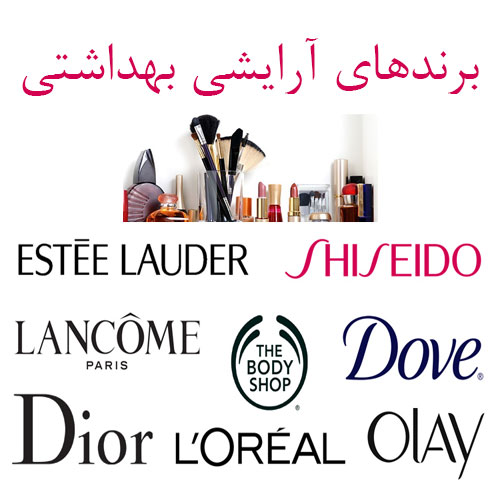
cosmetic-brands-og
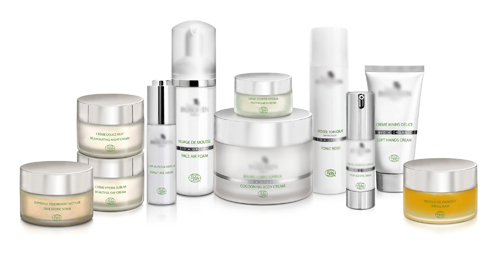
cosmetic-class
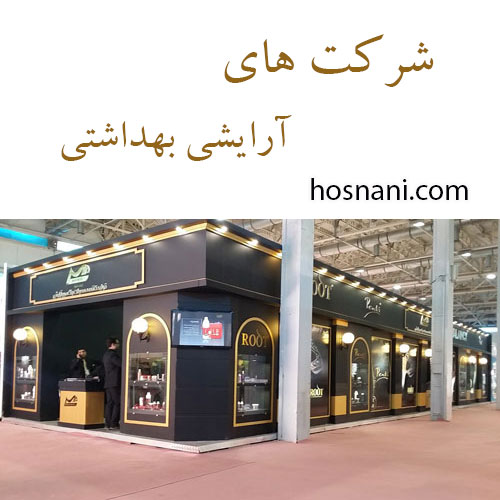
cosmetic-companies-og
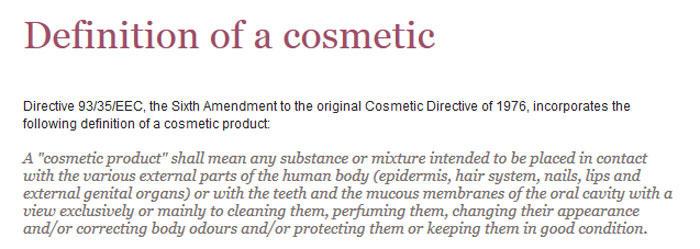
cosmetic-definition-ctpa

cosmetic-definition-fda

cosmetic-directory

cosmetic-game-og

cosmetic-import-statistics-og

cosmetic-importers-og
واژه «کازمتیک» در مقالات سایت احسان حسنانی
پوست در دوره یائسگی
اکثر خانم ها در هنگام یائسگی دچار خشکی و خارش پوست می شوند. استفاده از کرم های مرطوب کننده و دوری از مواد آلرژی زا بهترین راهکارهای مقابله با این موضوع است. در این مقاله راهکارهای دیگر توضیح داده می شوند.
9. عدم استفاده از صابون های عطری و نامرغوب
منبع:
اسلاید آموزشی دکتر محمد بقایی با عنوان
کازمتیک - مراقبت های پوستی در دوره یائسگی
مشاهده مطلباسیدهای میوه ای چه ربطی به میوه دارند
اسیدهای میوه ای نام دیگریست که به اسیدهای آلفا هیدروکسی اطلاق می شود. گلایکولیک اسید که از نیشکر به دست می آید، رایجترین، پرمصرف ترین و پرنفوذ ترین اسید میوه ای می باشد. لاکتیک، مالیک، تارتاریک و سیتریک اسید که از شیر، سیب، انگور و مرکبات به دست می آیند، از دیگر انواع اسیدهای میوه ای می باشند.
اسیدهای میوه ای یا آلفا هیدروکسی اسیدها امروزه مصرف گسترده ای در صنعت کازمتیک و آرایشی بهداشتی دارند.
اسیدهای آلفا هیدروکسی
(اسیدهای میوه ای)
به نوع تقسیم می شوند.
مشاهده مطلبتعریف رسمی واژه آرایشی بهداشتی
مواد یا محصولاتی كه به منظور تمیز كردن ، معطر كردن، زیبا کردن و یا محافظت، با بخش های خارجی بدن (پوست، مو و ناخن) در تماس هستند. لغت کازمتیک در انگلیسی می تواند هم به صورت اسم و هم به صورت صفت به کار گرفته شود. اتحادیه اروپا و سازمان غذا و داروی آمریکا هر یک تعاریف رسمی مربوط به خودشان را در مورد یک محصول آرایشی بهداشتی دارند.مشاهده مطلب
تاریخچه کازمتیک و آرایش در مصر باستان
در مصر باستان اقدامات کازمتیکی یا آرایشی بهداشتی نه فقط برای زیبایی بلکه برای تشریفات مذهبی نیز به کار گرفته می شد.
منبع:
اسلاید آموزشی دکتر محمد بقایی با عنوان
کازمتیک در مصر باستان
مشاهده مطلبواژه «کازمتیک» در منابع و ترجمه های احسان حسنانی
In today’s image-conscious society, people are looking for an affordable cosmetic hair loss solution that delivers on its promises. This presents an opportunity for high performance, clinically proven anti-hair loss products. (Capixyl)
ARACHIDYL ALCOHOL — A fatty alcohol derived from coco- nuts, used as an emulsion stabilizer in cosmetic products. ARACHIDYL GLUCOSIDE — Obtained through the condensation of arachidyl alcohol, a fatty alcohol, and glucose. Used in cosmetic products as a surfactant and emulsifier. (INCI dictionary)
ASCORBIC ACID — Vitamin C. Powerful antioxidant and nutrient, very beneficial to the skin. Plays an essential role in building collagen, the connective tissue that makes up 70 percent of our skin. Vitamin C is also a natural preservative, protecting both the oil and water phases of cosmetics. Ascorbic acid is a water-soluble form of vitamin C. (See also Calcium ascorbate.) (INCI dictionary)
آسکوربيك اسيد يا ويتامين سي: آنتي اكسيدان و ماده مغذي قدرتمند است كه براي پوست مزاياي زيادي دارد. نقش اساسي در ساخت كلاژن دارد كه 70 درصد بافت هم بند پوست را تشكيل مي دهد. ويتامين سي همچنين يك ماده پرزرواتيو يا نگهدارنده طبيعي است كه فاز آبي و روغني محصولات آرايشي- بهداشتي را محافظت مي كند. آسکوربيك اسيد فرم قابل حل در آب ويتامين سي است. (به كلسيم آسكوربات نيز مراجعه شود)
BEHENYL ALCOHOL — A fatty alcohol derived from coconuts, used as an emulsion stabilizer in cosmetic products. (INCI dictionary)
BETA VULGARIS — Beet Root Extract. Rich in polysaccharides, this powerful humectant is clinically proven to boost the skin’s natural moisturizing factor, forming a film on the skin that actually locks moisture in for up to 8 hours. Phytonutrients enhance cell renewal and a high antioxidant content protects skin from free radical damage. The extract or juice of beets is also sometimes used as a natural red color in cosmetics. (INCI dictionary)
عصاره ريشه چغندر: غني از پلي ساكاريدها: ماده هيومكتانت يا جاذب الرطوبه قدرتمند كه به صورت كلينيكي اثبات شده كه مي تواند فاكتورهاي مرطوب كننده پوست را تقويت كند. لايه اي روي پوست تشكيل مي دهد كه رطوبت را براي 8 ساعت روي پوست نگه مي دارد. مواد مغذي موجود در چغندر نوسازي سلولي را افزايش داده و محتواي بالاي آنتي اكسيدان آن از پوست در برابر آسيب هاي ناشي از راديكال هاي آزاد محافظت مي كند. عصاره يا شيره چغندر گاهي به عنوان رنگ قرمز طبيعي در محصولات کازمتیک استفاده مي شود.
CELLULOSE GUM — The most abundant polymer found in nature. Used as a setting agent in hairsprays, styling gels and mousses. A natural alternative to synthetic polymers (such as PVP) found in most mass-produced styling aids. Also used as a binder and thickener in cosmetic products. (INCI dictionary)
CERA ALBA — Beeswax. A natural humectant, also used in cosmetics as an emulsifier and thickening agent. (INCI dictionary)
موم زنبور عسل: ماده هيومكتانت طبيعي كه در محصولات كازمتيك به عنوان امولسيون كننده و قوام دهنده استفاده مي شود.
CITRIC ACID — Extract from citrus fruits used as a natural pH adjuster in cosmetics.Added to shampoos, it acts as a chelating agent, binding to chlorine and iron (from hard water) and removing them from the hair. (INCI dictionary)
سيتريك اسيد: عصاره به دست آمده از ميوه هاي مركبات كه براي تنظيم pH به محصولات كازمتيك اضافه مي شود. از سيتريك اسيد در شامپو به عنوان شلات كننده براي اتصال كلر و آهن و خارج كردن آن از آب سخت استفاده مي شود. به اين ترتيب اين مواد روي موها رسوب نمي كند.
CITRUS MEDICA LIMONUM — Lemon Oil/Lemon Peel Oil. Essential oil with antioxidant and antibacterial properties, often used in cosmetics as a skin freshener and for its cool, pleasant fragrance. (INCI dictionary)
روغن پوست ليمو يا روغن ليمو: اسانس روغني با ويژگي هاي آنتي اكسيدان و ضدميكروبي. در صنعت كازمتيك به عنوان طراوت دهنده پوست استفاده مي شود. رايحه عطر ليمو خنك و لذت بخش است.
COCOS NUCIFERA OIL — Coconut Oil. Rich emollient exressed from coconuts. It is naturally converted into a soap through a saponification reaction with an alkaline salt. Beware of cosmetics that bill themselves as natural and use a synthetically processed derivative, sodium lauryl sulfate, claiming it comes from coconut oil. Accept nothing but the real thing in its natural form. (INCI dictionary)
روغن نارگيل: يك امولينت غني، استخراج شده از نارگيل. در فرايند صابوني سازي در حضور نمك هاي قليايي به صابون تبديل مي شود. برخي محصولات آرايشي- بهداشتي ادعا مي كنند كه طبيعي هستند و از مشتقات سنتزي مثل سديم لوريل سولفات استفاده مي كند. اما ادعا مي كند كه حاوي روغن نارگيل هستند. اگر دقت كرده باشيد در تبليغ بسياري از شامپوها گفته شده حاوي روغن نارگيل، در صورتي كه اينگونه نيست. روغن نارگيل اگرچه به عنوان ماده اوليه در فرايند ساخت سديم لوريل اتر سولفات ممكن است استفاده شود اما اين موضوع نمي تواند موجب شود كه استفاده كننده اين تركيب چنين ادعايي كند.
COPERNICIA CERIFERA — Carnauba Wax. Plant wax used as a thickening agent in cosmetics, and to increase the spreadability of powdered makeup for better coverage. (INCI dictionary)
واكس كارنوبا: واكس ياموم گياهي كه به عنوان قوام دهنده در محصولات آرايشي- بهداشتي (كازمتيك) استفاده مي شود تا قابليت پخش لوازم آرايشي پودري را افزايش داده و پوشش آنها را بهتر كند.
CORIANDRUM SATIVUM — Coriander Seed Oil. Antibacterial, often used in cosmetics for its spicy fragrance. (INCI dictionary)
روغن بذر گشنيز: ضدباكتري، به علت رايحه اسپايسي يا تندي كه دارد در صنعت كازمتيك استفاده مي شود.
CYAMOPSIS TETRAGONOLOBA — Guar Gum. Extract from the guar bean, used as a thickener and emulsifier in cosmetic products. (INCI dictionary)
D-ALPHA TOCOPHEROL — Vitamin E. The most potent anti-oxidant vitamin around, it protects skin from cancer-causing free radicals and is essential for proper utilization of oxygen in the tissues. In cosmetics it also acts as a natural preservative, protecting the oil phase in creams and lotions. (INCI dictionary)
دي آلفا توكوفرول، ويتامين E: قويترين ويتامين آنتي اكسيدان، از پوست در برابر راديكال هاي آزاد سرطان زا محافظت مي كند. براي استفاده بهتر اكسيژن توسط بافتها مورد نياز است. در صنعت كازمتيك به عنوان نگهدارنده طبيعي استفاده مي شود تا از فاز روغني كرمها و لوسيون ها محافظت كند.
DAUCUS CAROTA SATIVA ROOT EXTRACT — Carrot Oil. The seeds of carrots yield an essential oil rich in beta carotene, orange or red compounds that are precursors to vitamin A and occur naturally in plants. Also high in vitamin E, carrot oil promotes skin cell regeneration and stimulates the production of sebum in dry scalp and skin. Its high antioxidant content makes it an excellent natural preservative in cosmetic formulations. (INCI dictionary)
ERYTHRAEA CENTAURIUM — Centaury, Century Herb. Used in cosmetics for its soothing and astringent properties. Applied topically, it helps even out skin tones and fade freckles and other skin discolorations. Also used as a natural color. (INCI dictionary)
گياه كوهستاني سنتاريوم: در محصولات آرايشي-بهداشتي براي ويژگي التيام بخشي و قابض آن استفاده مي شود. وقتي به صورت موضعي روي پوست ماليده مي شود، پوست را يكنواخت نموده، قوام مي بخشد، لكه ها را محو مي كند و تيرگي پوست را كاهش مي دهد. همچنين به عنوان رنگ طبيعي استفاده مي شود.
EVERNIA PRUNASTRI — Oakmoss. The extract from a lichen that grows on oak trees, used as a fixative in cosmetic products. (INCI dictionary)
FATTY ACID ESTERS — Waxes derived from plants or animals, which are less greasy than fatty acid extracts. Jojoba (Simondsia chinensis) and lanolin are examples of fatty acid esters. Used in absorption bases, and as emulsifiers in cosmetics. (INCI dictionary)
استر اسيدهاي چرب: واكس هايي كه از گياهان و حيوانات استخراج شده اند. از اسيدهاي چرب خاصيت چسبندگي كمتري دارد. جوجوبا و لانولين مثال هايي از استرهاي اسيد چرب هستند. از اين تركيبات به عنوان امولسيون ساز در محصولات آرايشي- بهداشتي استفاده مي شود.
FERULA GALBANIFLUA — Galbanum. Used in cosmetics for its leafy fragrance, and as a fixative for other scents. (INCI dictionary)
گياه فرولا يا باريجه: رايحه اي برگ مانند دارد و به عنوان تثبيت كننده ساير روايح استفاده مي شود. به مقاله جامعي كه در سايت احسان حسناني درباره باريجه نوشته شده است رجوع شود. باريجه در استان خراسان كشت مي شود.
FRUIT ACIDS — A group of acids naturally occurring in fruits and herbs, used in cosmetics for thousands of years to clear and smooth the complexion. They work by loosening the “glue” that holds the outer layer of cells to the surface of your skin, there- by encouraging exfoliation and more rapid turnover of skin cells. The patented trade name for fruit acids is Alpha-hydroxy acids, which are synthetically derived in most commercial formulations. (Alpha-hydroxy acids are now common ingredients in cosmetics, but were originally used as solvents in cleaning compounds and for tanning leather.) Some natural sources for fruit acids include bilberry herb, black currant, grapefruit, tomato, wine and grapes (glycolic, malic, pyruvic, benzylic, citric, tartaric and lactic acids). (INCI dictionary)
اسيدهاي ميوه اي: گروهي از اسيدهاي طبيعي موجود در ميوه ها و گياهان هستند كه سالهاست در صنايع آرايشي- بهداشتي و در محصولات كازمتيك براي پاك سازي و ايجاد پوستي صاف استفاده مي شود. اسيدهاي ميوه اي با شُل كردن چسب هايي كه لايه هاي بيروني سلول را به سطح پوست مي چسباند عمل مي كند. به اين ترتيب لايه برداري تسهيل شده و سرعت تكثير و تقسيم سلولي افزايش مي يابد. نام تجاري پتنت شده براي اسيدهاي ميوه اي، اسيدهاي آلفاهيدروكسي هست. اسيدهاي آلفاهيدروكسي كه بسيار در محصولات كازمتيك رايج شده اند در گذشته به عنوان حلال در تركيبات تميزكننده و همچنين در صنعت چرم سازي و دباغي مورد استفاده قرار مي گرفته است. برخي از منابع طبيعي اسيدهاي ميوه اي عبارتند از: زغال اخته يا بليبري، توت سياه يا بلك كارانت، گريپ فورت، گوجه، انگور. گلايگوليك اسيد، ماليك اسيد، پيروويك اسيد، بنزيليك اسيد، سيتريك اسيد، تارتاريك اسيد و لاكتيك اسيد جزء اسيدهاي ميوه اي هستند.
GLYCERIN — Vegetable Glycerin. Rich humectant, emollient and lubricant naturally extracted from vegetable oils, used in cosmetic formulations for thousands of years. (Synthetic glycerin, otherwise known as propylene glycol, is highly irritating to the skin and scalp and should be avoided.) (INCI dictionary)
GLYCEROL ISOSTEARATE — A glyceryl ester used in cosmetics as an emollient and thickening agent. (INCI dictionary)
گليسرول ايزو استئارات: استر گليسيريل مورد استفاده در صنعت كازمتيك به عنوان امولينت و قوام دهنده.
GLYCERYL CAPRYLATE — An emulsifier, also used in cosmetic formulations for its antimicrobial activity. (INCI dictionary)
GLYCERYL UNDECYLENATE — An emulsifier, also used in cosmetic formulations for its antimicrobial activity. Has skin-conditioning proper ties. (INCI dictionary)
JASMINUM OFFICINALE — Jasmine Oil. Essential oil of the aromatic flower, widely used in aromatherapy for its calming effect and as a natural fragrance in cosmetics and perfumes. A popular herbal medicine in China, very soothing to the skin and scalp. (INCI dictionary)
روغن جاسمين يا ياسمين: اسانس روغني گل آروماتيك و معطر كه به شكل گسترده در آروماتراپي يا رايحه درماني براي اثر تسكيني آن استفاده مي شود. همچنين يك ماده معطر طبيعي در صنايع عطرسازي و آرايشي- بهداشتي مي باشد. يك داروي گياهي بسيار محبوب در چين كه بسيار تسكين دهنده پوست و پوست سر مي باشد.
LONICERA CAPRIFOLIUM, LONICERA JAPONICA — Honey suckle, Japanese Honeysuckle. An excellent cleanser and purifier used in facial creams, shampoos and soaps. The oil adds a pleasant, sweet fragrance to cosmetics. (INCI dictionary)
پيچ امين الدوله يا پوني ساكل: تميزكننده عالي و پاك كننده عمقي مورد استفاده در كرم هاي صورت، شامپوها و صابون ها. اين ماده روغني معطر رايحه شيرين و دلپذيري به محصولات آرايشي- بهداشتي مي دهد.
MALTRODEXTRIN — Natural sugar from plant starches, used as a stabilizer in cosmetic preparations. (INCI dictionary)
MELALEUCA ALTERNIFOLIA — Tea Tree Oil. Essential oil with powerful antiseptic and germicidal properties, similar to eucalyptus oil. Due to its strong odor, it must be used in small amounts in cosmetics, but makes an excellent addition to dandruff shampoos and therapeutic masks and moisturizers. (INCI dictionary)
روغن درخت چای: اسانس روغني با خاصيت آنتي سپتيك قدرتمند، ضدباكتري (جرمي سايد) شبيه روغن اوكاليپتوس. به علت رايحه شديد و قدرتمندش بايد تنها به ميزان اندكي در محصولات آرايشي- بهداشتي استفاده گردد. در شامپوهاي ضدشوره و ماسك هاي درماني و مرطوب كننده استفاده مي شود.
MYRISTICA FRAGRANS — Nutmeg. A popular spice in cooking, the nutmeg essential oil is used in cosmetics for its exotic, spicy fragrance. (INCI dictionary)
جوز هندي: يك ادويه محبوب در آشپزي. اسانس روغني جوز هندي در محصولات آرايشي- بهداشتي به خاطر رايحه اسپايسي و اگزوتيك آن استفاده مي شود.
ORYZA SATIVA BRAN WAX — Rice Bran Wax. Used in cosmetics as a thickener and binding agent. (INCI dictionary)
موم سبوس برنج: به عنوان قوام دهنده و پيونددهنده در محصولات كازمتيك استفاده مي شود.
POTASSIUM SORBATE — The potassium salt of sorbic acid, a natural compound isolated from the oil of the rowan or mountain ash berry. A mild preservative used in foods, herbal supplements and cosmetics for its anti-microbial and anti-fungal proper ties. (INCI dictionary)
PRUNUS AMYGDALUS AMARA — Bitter Almond Oil. Essential oil used as a skin softener. Sometimes added to cosmetics for its mild, pleasant scent. (INCI dictionary)
PULLULAN — A polysaccharide made from starch, used in cosmetics as a water-binding and thickening agent. (INCI dictionary)
RETINYL PALMITATE — Vitamin A. Antioxidant vitamin widely used (both internally and topically) in the treatment of acne and other skin conditions. Its topical application promotes the formation of new skin cells and helps regulate oil secretion in the sebaceous glands. Par ticularly beneficial for dry or sun-exposed skin, it is often found in sun protection creams for its antioxidant proper ties and its soothing and hydrating effect on the skin. (A deficiency of vitamin A in the body reduces the mucopolysaccharides in the skin, which accelerates the skin’s aging process.) Also used as a natural preser- vative in cosmetics. (INCI dictionary)
RICINUS COMMUNIS — Castor Seed Oil. Humectant and skin soother, often added to lipsticks, glosses and other cosmetic prod- ucts to improve their texture. (INCI dictionary)
ROSA DAMASCENA FLOWER DISTILLATE — Rosewater. A byproduct of the distillation of fresh rose petals, this hydrosol or floral water is a natural hydrator and anti-irritant. Used in cosmetics since the 10th century, it is an excellent soothing agent for dry, sensitive skin. (INCI dictionary)
SESAMUM INDICUM — Sesame Oil. Similar to avocado oil, this rich emollient is high in linoleic and oleic fatty acids. Often used as a carry- ing agent for other ingredients in cosmetic formulations. (INCI dictionary)
SIMMONDSIA CHINENSIS SEED OIL — Jojoba Oil, Jojoba Wax. Waxy oil extracted from the bean, which helps the jojoba des- ert plant retain water during the long summer drought. When used in cosmetic preparations, it not only acts as a humectant, but actually creates a protective film over the skin and hair shaft that helps seal in moisture. The oil is highly stable and very effective on dry skin, dam- aged hair and split ends. (INCI dictionary)
SODIUM BENZOATE — A salt of benzoic acid, found naturally in cranberries, apples, plums and other fruits, and in cinnamon and ripe clove. Used in foods and cosmetic products as a mild preservative for its anti-bacterial and anti-fungal properties. (INCI dictionary)
SORBITAN STEREATE — A surfactant derived from berries and other plant sources, composed of sorbitol, a natural sweetener, and stearic acid, a fatty acid. Used in cosmetic products as an emulsifier and wetting agent. (INCI dictionary)
SPIRAEA ULMARIA — Meadowsweet. Also known as Lady of the Meadow and Meadow Queen, it was considered a sacred plant by the Druids. Used in cosmetics for sensitive skin for its mild, tonic effect. (INCI dictionary)
SQUALANE — A saturated hydrocarbon found in human sebum, added to cosmetics for its emollient and bactericidal proper ties. Squalane is typically obtained from shark liver oil, but the identical substance can be derived from olives. Olive oil squalane is more stable and much more compatible with the skin than its shark-de- rived counterpar t. (INCI dictionary)
SUCROSE LAURATE — A fatty acid ester derived from sugar, used in cosmetic products as a natural emulsifier and surfactant. (INCI dictionary)
THUJA OCCIDENTALIS — Cedar Leaf Oil. Adds a woody note to perfumes and other cosmetic products. (INCI dictionary)
THYMUS VULGARIS — Thyme. Antiseptic and tonic. Contributes an herbal note to the scent of cosmetic products. (INCI dictionary)
VANILLA PLANIFOLIA — Vanilla Oil. Used as a natural fragrance. VETIVERIA ZIZANIOIDES — Vetiver. Soothing essential oil used in cosmetics for its smoky, ear thy scent. Due to its sedative proper- ties, in India it is known as oil of tranquility. (INCI dictionary)
YEAST — High in protein and B vitamins. Added to cosmetics for its nutritional proper ties. (INCI dictionary)
ACETYL HEXAPEPTIDE 3: A non-toxic amino-peptide developed specifically to reduce wrinkles and the signs of premature aging. Acetyl Hexapeptide 3 is a cost-effective alternative to injections and surgical procedures. Acetyl Hexapeptide 3 temporarily limits the overproduction and release of neurotransmitters that initiate and control the intensity of facial muscle contractions. This reduction in intensity reduces and prevents the formation of dynamic wrinkles that make your skin look aged. This powerful ingredient reduces muscle contractions in a non-paralytic fashion and without toxic side effects. It is naturally derived and non-irritating to the skin. Attaching the hexapeptide to the fatty acid, acetyl, allows the resulting amino-peptide to be easily absorbed into the skin. At a 10% concentration, Acetyl Hexapeptide 3 has been shown to reduce the depth of wrinkles up to 30% after 30 days of trial use. (source: International Journal of Cosmetic Science, Vol. 24, No 5, p.303, October 2002). Currently, doctors are beginning to recommend use of Acetyl Hexapeptide 3 skin serums in conjunction with paralytic injections to prolong those results. (cellularskinrx.com)
HYALURONIC ACID: Hyaluronic Acid is a naturally occurring substance found throughout the body. It plays an important role in tissue hydration, lubrication and cellular function. Used as moisturizer, hyaluronic acid results in increased smoothness, softening and decreased wrinkles. It is an excellent hydrator used frequently during post-peel procedures to lubricate and soothe new skin cells. It offers an excellent environment for the growth of new cells and healing. It is extensively used by the cosmetic industry and by dermatologists in anti-aging and moisturizing products as HA is very hydroscopic (absorbs and retains water). Hyaluronic acid can absorb over 1000 times its weight in water. (cellularskinrx.com)
LIPOSHIELD®: Also know as phyto-melanin. Liposhield® is the first cosmetic ingredient designed to protect the skin from damaging high energy visible (HEV) light. It is a fractionated melanin compound, and can be used as an additional environmental defense against High Energy Visible light (HEV). It is designed to shield the skin from high energy blue/violet visible light. This novel, patent-pending ingredient may help to prevent premature aging and hyperpigmentation. (cellularskinrx.com)
PALMITOYL OLIGOPEPTIDE: Palmitoyl Oligopeptide (also known as palmitoyl pentapeptide, Dermaxyl, Matrixyl and Matrixyl 3000) is an engineered amino-peptide that when added to a culture of fibroblasts (key skin cells), stimulates collagen, elastin and glucosaminoglycans production. These are the key components of healthy-looking skin. Clinically proven to reduce wrinkle depth by increasing hyaluronic acid and collagen production, Palmitoyl Oligopeptide (PO)is a synthetic protein that is a fragment of collagen combined with palmitic acid to make it more lipophillic, to improve its stability and to enhance its affinity towards human skin. As with Palmitoyl Pentapeptide-3, one could look at PO as a man-made precursor to collagen. PO was developed through research to identify a substance that would behave similarly to retinoic acid but without its drawbacks, especially in regards to synthesizing collagen. The reported results are as follows: In vitro: Increases collagen production by the fibroblasts by as much as 350%. Increases hyaluronic acid production by the fibroblasts by as much as 146%. In vivo: The following statistics were gathered using image analysis of volunteers who used crèmes containing a 3% concentration of Biopeptide-CL for 28 days. Surface roughness -- Reduced 17% Mean depth of wrinkles -- Reduced 23% Depth of main wrinkle -- Reduced 39% Skin thickness -- Increased 4%. The increase in skin thickness was considered especially notable and contrasts with the 6% reduction of the skin thickness that occurs after 10 years of aging. PO is a potent active cosmetic ingredient without the adverse effects (including irritation, dehydration or long-term toxicity and instability) characteristic of retinoids. Used in CSRx Lip Remodeling Treatment, Intensive Eye Therapy Creme, Firming Peptide Eye Creme, and Fresh Pout Lip Balm. (cellularskinrx.com)
PHYTO-MELANIN: Also known as Liposhield®, Phyto-Melanin is the first cosmetic ingredient designed to protect the skin from damaging high energy visible (HEV) light. It is a fractionated melanin compound, and can be used as an additional environmental defense against High Energy Visible light (HEV). It is designed to shield the skin from high energy blue/violet visible light. This novel, patent-pending ingredient may help to prevent premature aging and hyperpigmentation. (cellularskinrx.com)
SHEA BUTTER: An excellent emollient, moisturizer and anti-inflammatory agent derived from the crushing and boiling of the seeds from the Shea tree. Has some natural ultraviolet protection property, offering up to spf 6 but should not be used exclusively as a sunscreen. Absorbs rapidly into the skin without leaving a greasy film. Used often in cosmetic products and also in food products as a substitute for cocoa butter. (cellularskinrx.com)
TETRAHEXYLDECYL ASCORBATE: Stable, oil-soluble vitamin C ester able to be used in cosmetic products with neutral to high pH. Protects from lipid peroxidation and limits melaninogenesis. Limits UV damage and stimulates collagen production. Used in Smooth Surface Instant Line-Filler. (cellularskinrx.com)
Linoleic Acid: An essential fatty acid. Used in cosmetics, vitamins. Alternatives: (See alternatives to Fatty Acids.) (peta.org)
Mink Oil: From minks. In cosmetics, creams, etc. Alternatives: vegetable oils and emollients such as avocado oil, almond oil, and jojoba oil. (peta.org)
Lactose: Milk sugar from milk of mammals. In eye lotions, foods, tablets, cosmetics, baked goods, medicines. Alternatives: plant milk sugars. (peta.org)
Emu Oil: From flightless ratite birds native to Australia and now factory-farmed. Used in cosmetics and creams. Alternatives: vegetable and plant oils. (peta.org)
Nucleic Acids: In the nucleus of all living cells. Used in cosmetics, shampoos, conditioners, etc. Also in vitamins, supplements. Alternatives: plant sources. (peta.org)
Animal Fats and Oils: In foods, cosmetics, etc. Highly allergenic. Alternatives: olive oil, wheat germ oil, coconut oil, flaxseed oil, almond oil, safflower oil, etc. (peta.org)
Hydrolyzed Animal Protein: In cosmetics, especially shampoo and hair treatments. Alternatives: soy protein, other vegetable proteins, amla oil (see alternatives to Keratin). (peta.org)
Biotin Vitamin H Vitamin B Factor: In every living cell and in larger amounts in milk and yeast. Used as a texturizer in cosmetics, shampoos, and creams. Alternatives: plant sources. (peta.org)
Amino Acids: The building blocks of protein in all animals and plants. In cosmetics, vitamins, supplements, shampoos, etc. Alternatives: synthetics, plant sources. (peta.org)
Tyrosine: Amino acid often of plant or synthetic origin but sometimes hydrolyzed from casein (milk). Used in cosmetics and creams. Derivative: Glucose Tyrosinase. (peta.org)
Milk Protein: Hydrolyzed milk protein. From the milk of cows. In cosmetics, shampoos, moisturizers, conditioners, etc. Alternatives: soy protein, other plant proteins. (peta.org)
Casein Caseinate Sodium Caseinate: Milk protein. In “nondairy” creamers, soy cheese, many cosmetics, hair preparations, beauty masks. Alternatives: soy protein, soy milk, and other vegetable milks. (peta.org)
Lard: Fat from hog abdomens. In shaving creams, soaps, cosmetics. In baked goods, French fries, refried beans, and many other foods. Alternatives: pure vegetable fats or oils. (peta.org)
Squalene: Oil from shark livers, etc. In cosmetics, moisturizers, hair dyes, surface-active agents. Alternatives: vegetable emollients such as olive oil, wheat germ oil, rice bran oil, etc. (peta.org)
Turtle Oil Sea Turtle Oil: From the muscles and genitals of giant sea turtles. In soap, skin creams, nail creams, other cosmetics. Alternatives: vegetable emollients (see alternatives to Animal Fats and Oils). (peta.org)
Pristane: Obtained from the liver oil of sharks and from whale ambergris. (See Squalene, Ambergris.) Used as a lubricant and anti-corrosive agent. In cosmetics. Alternatives: plant oils, synthetics. (peta.org)
Carotene Provitamin A Beta Carotene: A pigment found in many animal tissues and in all plants. When used as an additive, typically derived from plant sources. Used as a coloring in cosmetics and in the manufacture of vitamin A. (peta.org)
Hyaluronic Acid: When animal-derived, a protein found in umbilical cords and the fluids around the joints. Used in cosmetics and some medical applications. Alternatives: synthetic hyaluronic acid, plant oils. (peta.org)
Royal Jelly: Secretion from the throat glands of worker honeybees. Fed to the larvae in a colony and to all queen larvae. No proven value in cosmetics preparations. Alternatives: aloe vera, comfrey, other plant derivatives. (peta.org)
Cholesterol: A steroid alcohol in all animal fats and oils, nervous tissue, egg yolk, and blood. Can be derived from lanolin. In cosmetics, eye creams, shampoos, etc. Alternatives: solid complex alcohols (sterols) from plant sources. (peta.org)
“Natural Sources”: Can mean animal or vegetable sources. Most often in the health-food industry, especially in the cosmetics area, it means animal sources, such as animal elastin, glands, fat, protein, and oil. Alternatives: plant sources. (peta.org)
Castor Castoreum: Creamy substance with strong odor, originally from muskrat and beaver genitals but now typically synthetic. Used as a fixative in perfume and incense. While some cosmetics companies continue to use animal castor, the majority do not. (peta.org)
Allantoin: Uric acid from cows, most mammals. Also in many plants (especially comfrey). In cosmetics (especially creams and lotions) and used in treatment of wounds and ulcers. Derivatives: Alcloxa, Aldioxa. Alternatives: extract of comfrey root, synthetics. (peta.org)
Isinglass: A form of gelatin prepared from the internal membranes of fish bladders. Sometimes used in “clearing” wines and in foods. Alternatives: bentonite clay, “Japanese isinglass,” agar-agar (see alternatives to Gelatin), mica, a mineral used in cosmetics. (peta.org)
Guanine Pearl Essence: Obtained from scales of fish. Constituent of ribonucleic acid and deoxyribonucleic acid and found in all animal and plant tissues. In shampoo, nail polish, other cosmetics. Alternatives: leguminous plants, synthetic pearl, or aluminum and bronze particles. (peta.org)
Albumen: In eggs, milk, muscles, blood, and many vegetable tissues and fluids. In cosmetics, albumen is usually derived from egg whites and used as a coagulating agent. May cause allergic reaction. In cakes, cookies, candies, etc. Egg whites sometimes used in “clearing” wines. Derivative: Albumin. (peta.org)
Fatty Acids: Can be one or any mixture of liquid and solid acids such as caprylic, lauric, myristic, oleic, palmitic, and stearic. Used in bubble baths, lipsticks, soap, detergents, cosmetics, food. Alternatives: vegetable-derived acids, soy lecithin, safflower oil, bitter almond oil, sunflower oil, etc. (peta.org)
Myristic Acid: Organic acid typically derived from nut oils but occasionally of animal origin. Used in shampoos, creams, cosmetics. In food flavorings. Derivatives: Isopropyl Myristate, Myristal Ether Sulfate, Myristyls, Oleyl Myristate. Alternatives: nut butters, oil of lovage, coconut oil, extract from seed kernels of nutmeg, etc. (peta.org)
Honey: Food for bees, made by bees. Can cause allergic reactions. Used as a coloring and an emollient in cosmetics and as a flavoring in foods. Should never be fed to infants. Alternatives: in foods—maple syrup, date sugar, syrups made from grains such as barley malt, turbinado sugar, molasses; in cosmetics—vegetable colors and oils. (peta.org)
Vitamin A: Can come from fish liver oil (e.g., shark liver oil), egg yolk, butter, lemongrass, wheat germ oil, carotene in carrots, and synthetics. An aliphatic alcohol. In cosmetics, creams, perfumes, hair dyes, etc. In vitamins, supplements. Alternatives: carrots, other vegetables, synthetics. (Please note that Vitamin A exists in two forms: see also Carotene, Retinol.) (peta.org)
Glycerin Glycerol: A byproduct of soap manufacture (normally uses animal fat). In cosmetics, foods, mouthwashes, chewing gum, toothpastes, soaps, ointments, medicines, lubricants, transmission and brake fluid, and plastics. Derivatives: Glycerides, Glyceryls, Glycreth-26, Polyglycerol. Alternatives: vegetable glycerin (a byproduct of vegetable oil soap), derivatives of seaweed, petroleum. (peta.org)
Colors Dyes: Pigments from animal, plant, and synthetic sources used to color foods, cosmetics, and other products. Cochineal is from insects. Widely used FD&C and D&C colors are coal-tar (bituminous coal) derivatives that are continuously tested on animals because of their carcinogenic properties. Alternatives: grapes, beets, turmeric, saffron, carrots, chlorophyll, annatto, alkanet. (peta.org)
Vitamin D Ergocalciferol Vitamin D2 Ergosterol Provitamin D2 Calciferol Vitamin D3: Vitamin D can come from fish liver oil, milk, egg yolks, and other animal products but can also come from plant sources. Vitamin D2 is typically vegan. Vitamin D3 may be from an animal source. All the D vitamins can be in creams, lotions, other cosmetics, vitamin tablets, etc. Alternatives: plant and mineral sources, synthetics, completely vegetarian vitamins, exposure of skin to sunshine. (peta.org)
Lanolin Lanolin Acids Wool Fat Wool Wax: A product of the oil glands of sheep, extracted from their wool. Used as an emollient in many skin-care products and cosmetics and in medicines. An allergen with no proven effectiveness. (See Wool for cruelty to sheep.) Derivatives: Aliphatic Alcohols, Cholesterin, Isopropyl Lanolate, Laneth, Lanogene, Lanolin Alcohols, Lanosterols, Sterols, Triterpene Alcohols. Alternatives: plant and vegetable oils. (peta.org)
Lecithin Choline Bitartrate: Waxy substance in nervous tissue of all living organisms. But frequently obtained for commercial purposes from eggs and soybeans. Also from nerve tissue, blood, milk, corn. Choline bitartrate, the basic constituent of lecithin, is in many animal and plant tissues and prepared synthetically. Lecithin can be in eye creams, lipsticks, liquid powders, hand creams, lotions, soaps, shampoos, other cosmetics, and some medicines. Alternatives: soybean lecithin, synthetics. (peta.org)
Tallow Tallow Fatty Alcohol Stearic Acid: Rendered beef fat. May cause eczema and blackheads. In wax paper, crayons, margarines, paints, rubber, lubricants, etc. In candles, soaps, lipsticks, shaving creams, other cosmetics. Chemicals (e.g., PCB) can be in animal tallow. Derivatives: Sodium Tallowate, Tallow Acid, Tallow Amide, Tallow Amine, Talloweth-6, Tallow Glycerides, Tallow Imidazoline. Alternatives: vegetable tallow, Japan tallow, paraffin, ceresin (see alternatives to Beeswax). Paraffin is usually from petroleum, wood, coal, or shale oil. (peta.org)
Carmine Cochineal Carminic Acid: Red pigment from the crushed female cochineal insect. Reportedly, 70,000 beetles must be killed to produce one pound of this red dye. Used in cosmetics, shampoos, red apple sauce, and other foods (including red lollipops and food coloring). May cause allergic reaction. Alternatives: beet juice (used in powders, rouges, shampoos; no known toxicity), alkanet root (from the root of this herb-like tree; used as a red dye for inks, wines, lip balms, etc.; no known toxicity; can also be combined to make a copper or blue coloring). (See Colors.) (peta.org)
Stearic Acid: When animal-derived, a fat from cows, pigs, and sheep and from dogs and cats euthanized in animal shelters, etc. May also be of plant origin, including from cocoa butter and shea butter. Can be harsh, irritating. Used in cosmetics, soaps, lubricants, candles, hairspray, conditioners, deodorants, creams, chewing gum, food flavoring. Derivatives: Stearamide, Stearamine, Stearates, Stearic Hydrazide, Stearone, Stearoxytrimethylsilane, Stearoyl Lactylic Acid, Stearyl Betaine, Stearyl Imidazoline. Alternatives: Stearic acid can be found in many vegetable fats, coconut. (peta.org)
Gelatin Gel: Protein obtained by boiling skin, tendons, ligaments, and/or bones in water. From cows and pigs. Used in shampoos, face masks, and other cosmetics. Used as a thickener for fruit gelatins and puddings (e.g., Jell-O). In candies, marshmallows, cakes, ice cream, yogurts. On photographic film and in vitamins as a coating and as capsules. Sometimes used to assist in “clearing” wines. Alternatives: carrageen (carrageenan, Irish moss), seaweeds (algin, agar-agar, kelp—used in jellies, plastics, medicine), pectin from fruits, dextrins, locust bean gum, cotton gum, silica gel. Marshmallows were originally made from the root of the marshmallow plant. Vegetarian capsules are now available from several companies. Digital cameras don’t use film. (peta.org)
Beeswax Honeycomb: Wax obtained from melting honeycomb with boiling water, straining it, and cooling it. From virgin bees. Very cheap and widely used. May be harmful to the skin. In lipsticks and many other cosmetics, especially face creams, lotions, mascara, eye creams and shadows, face makeup, nail whiteners, lip balms, etc. Derivatives: Cera Flava. Alternatives: paraffin, vegetable oils and fats, ceresin (aka ceresine, earth wax; made from the mineral ozokerite; replaces beeswax in cosmetics; also used to wax paper, to make polishing cloths, in dentistry for taking wax impressions, and in candle-making), carnauba wax (from the Brazilian palm tree; used in many cosmetics, including lipstick; rarely causes allergic reactions), candelilla wax (from candelilla plants; used in many cosmetics, including lipstick; also in the manufacture of rubber and phonograph records, in waterproofing and writing inks; no known toxicity), Japan wax (vegetable wax, Japan tallow; fat from the fruit of a tree grown in Japan and China). (peta.org)
L'Oreal: L'Oreal is the world's largest cosmetics and beauty company and has its head office in Paris, France. It specializes in hair color amongst other things, but it was actually its invention of permanent hair color that began this mighty empire. In 1907 a French chemist, Eugene Schueller, developed an innovative hair color formula that chemically made hair color permanent. This the beginning of the L'Oreal company which in 2007 was listed as having 63,360 employees and a revenue of 17.06 billion Euros!! (thehairstyler.com)
English: mr wipes concentrated stain remover for clothes is speically developed for removing the toughest stains like sludge, grass, cosmetics, oil, juice, tea, coffee. it is effective also in collar and cus grime. thanks to its special formula, it does not damage your fabric’s color and tissue. it is suitable for hand machine usage.
ترجمه به فارسی: لکه بر تغلیظ شده Mr. Wipes برای زدودن سرسخت ترین لکه ها مثل لکه های لجن، چمن، محصولات آرایشی، روغن، آبمیوه، چای و قهوه به شکل خاص طراحی شده است. برای لکه های یقه لباس مؤثر است. فرمولاسیون خاص، رنگ و بافت پارچه را تخریب نمی کند. برای شستشو با دست و ماشین مناسب است.
ARACHIDYL ALCOHOL — A fatty alcohol derived from coco- nuts, used as an emulsion stabilizer in cosmetic products. ARACHIDYL GLUCOSIDE — Obtained through the condensation of arachidyl alcohol, a fatty alcohol, and glucose. Used in cosmetic products as a surfactant and emulsifier. (INCI dictionary)
BEHENYL ALCOHOL — A fatty alcohol derived from coconuts, used as an emulsion stabilizer in cosmetic products. (INCI dictionary)
CELLULOSE GUM — The most abundant polymer found in nature. Used as a setting agent in hairsprays, styling gels and mousses. A natural alternative to synthetic polymers (such as PVP) found in most mass-produced styling aids. Also used as a binder and thickener in cosmetic products. (INCI dictionary)
CYAMOPSIS TETRAGONOLOBA — Guar Gum. Extract from the guar bean, used as a thickener and emulsifier in cosmetic products. (INCI dictionary)
EVERNIA PRUNASTRI — Oakmoss. The extract from a lichen that grows on oak trees, used as a fixative in cosmetic products. (INCI dictionary)
SODIUM BENZOATE — A salt of benzoic acid, found naturally in cranberries, apples, plums and other fruits, and in cinnamon and ripe clove. Used in foods and cosmetic products as a mild preservative for its anti-bacterial and anti-fungal properties. (INCI dictionary)
SORBITAN STEREATE — A surfactant derived from berries and other plant sources, composed of sorbitol, a natural sweetener, and stearic acid, a fatty acid. Used in cosmetic products as an emulsifier and wetting agent. (INCI dictionary)
SUCROSE LAURATE — A fatty acid ester derived from sugar, used in cosmetic products as a natural emulsifier and surfactant. (INCI dictionary)
THUJA OCCIDENTALIS — Cedar Leaf Oil. Adds a woody note to perfumes and other cosmetic products. (INCI dictionary)
THYMUS VULGARIS — Thyme. Antiseptic and tonic. Contributes an herbal note to the scent of cosmetic products. (INCI dictionary)
SHEA BUTTER: An excellent emollient, moisturizer and anti-inflammatory agent derived from the crushing and boiling of the seeds from the Shea tree. Has some natural ultraviolet protection property, offering up to spf 6 but should not be used exclusively as a sunscreen. Absorbs rapidly into the skin without leaving a greasy film. Used often in cosmetic products and also in food products as a substitute for cocoa butter. (cellularskinrx.com)
TETRAHEXYLDECYL ASCORBATE: Stable, oil-soluble vitamin C ester able to be used in cosmetic products with neutral to high pH. Protects from lipid peroxidation and limits melaninogenesis. Limits UV damage and stimulates collagen production. Used in Smooth Surface Instant Line-Filler. (cellularskinrx.com)

لوگوی مدرسه تابستانی کازمتیک ایران که در تابستان سال 94 اقدام به برگزاری کلاس های آموزشی نمود.
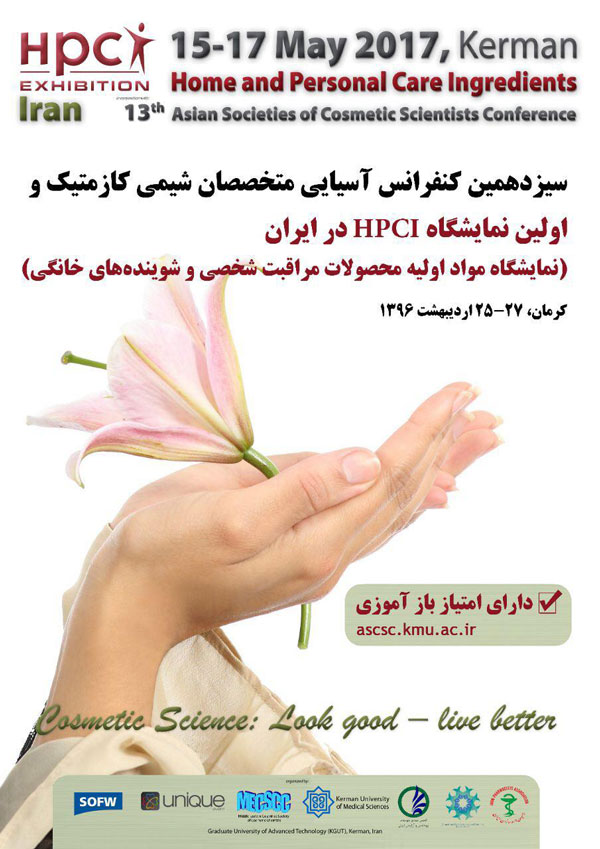
سیزدهمین کنفرانس آسیایی متخصصان کازمتیک و اولین نمایشگاه HPCI در ایران، ۲۵-۲۷ اردیبهشت۹۶ ، کرمان-ایران، دارای امتیاز بازآموزی

دکتر مژگان مدرسی داروساز PHD فارماسیوتیکس با گرایش کازمتیک ، سخنران مدعو از کشور انگلستان عضو اصلی انجمن متخصصین کازمتیک انگلستان، موضوع سخنرانی رگیولیتوری در کازمتیک
Dr Mojgan Moddaresi- Team leader of Personal Care Regulatory Ltd.- England

کلاوودی ویلیمین از کشور فرانسه ، کازمتولوژیست، از مدیران ارشد لوری آل ، رییس اسبق فدراسیون جهانی کازمتیک ٢٠١٤ الی٢٠١٥ سخنران مدعو موضوع CONSTITUTIVE PIGMENTATION AND SKIN COLOR DIVERSITY
CLaudie Willemin (Chemist)- Scientific Editor of IFSCC Magazine- France

خاویر رومئو ، کازمتولوژیست ، بارسلون اسپانیا، سخنران مدعو کنفرانس کرمان، رییس اسبق فدراسیون جهانی کازمتیک ٢٠٠٨ الی ٢٠٠٩ . موضوع پرزرواتیوهای جایگزین
Xavier Romeu- General manager of Unicosrom- Spain

دکتر یوشیکونی یاماموتا PHD فارماسیوتیکیس ، رییس زون ٢ فدراسیون جهانی متخصصین کازمتیک ، سخنران مدعو کنفرانس آسیایی تهران ، آروماتراپی در ژاپن
Dr Yoshikuni Yamamoto- President of IFSCC zone II- Japan

دکتر محمد بقایی، رئیس انجمن متخصصین شیمی کازمتیک کشورهای خاورمیانه: کنفرانس آسیائی متخصصین شیمی کازمتیک کرمان بهترین فرصت برای تبادل دانش فنی و انتقال تکنولوژی است.
Dr M.Baghaei president of MECSCC،Cosmetic and Hygienic Sciences Technology research center
منبع: ascsc2017 Telegram channel
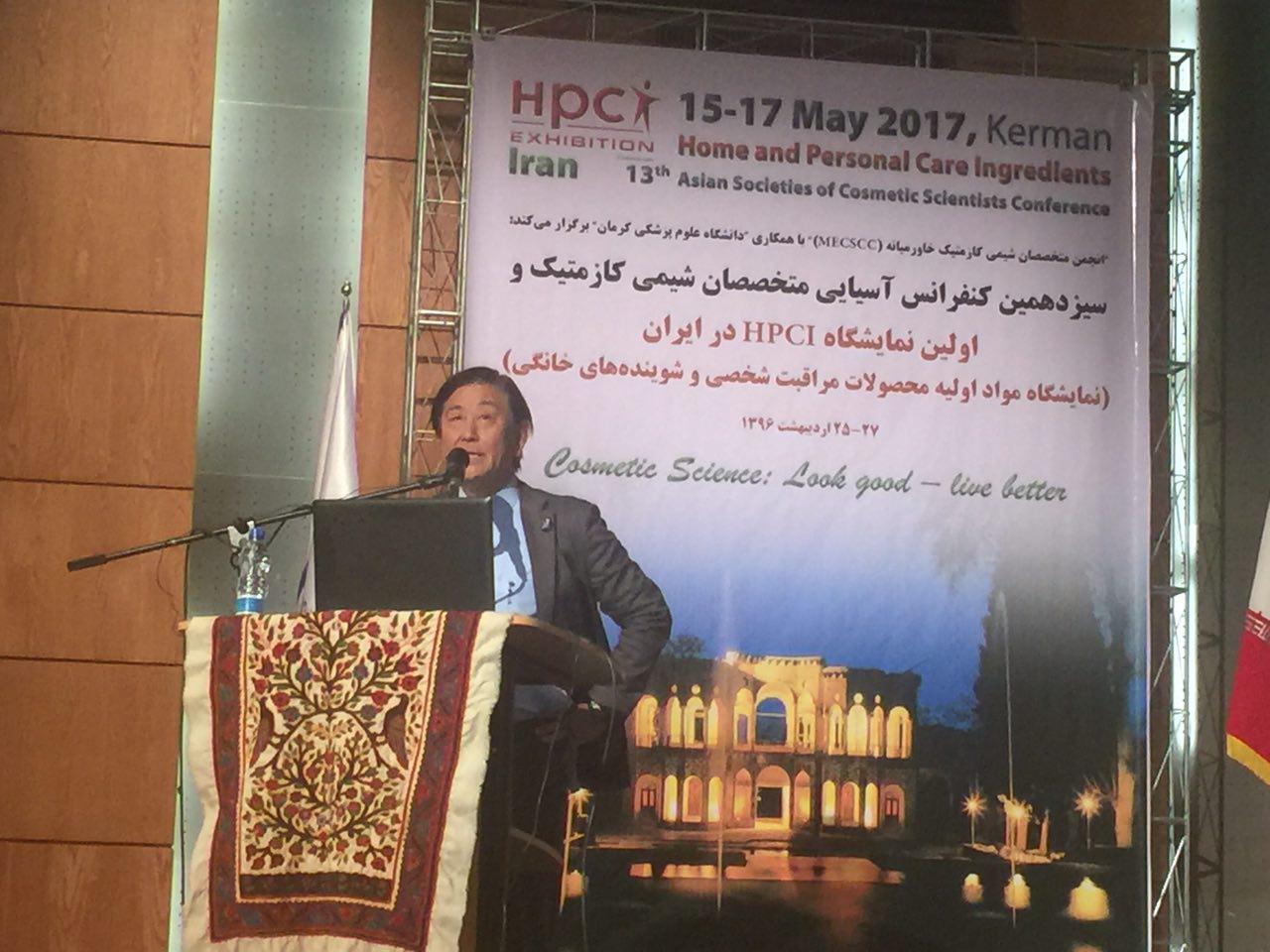
سخنرانی دکتر یاموموتو رییس زون ٢ فدراسیون جهانی متخصصین کازمتیک
منبع: کانال تلگرام کنفرانس کازمتیک کرمان

مراسم افتتاحیه سیزدهمین کنفرانس آسیایی متخصصان شیمی کازمتیک کرمان
منبع: کانال تلگرام کنفرانس کازمتیک کرمان
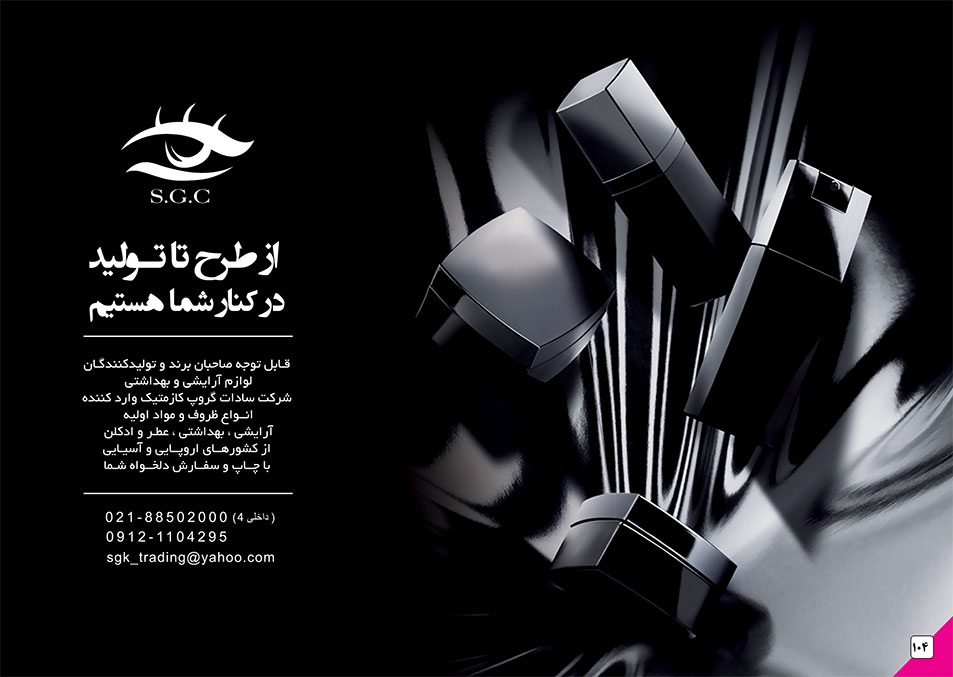
شرکت سادات گروپ کازمتیک واردکننده انواع ظروف و مواد اولیه آرایشی بهداشتی، عطر و ادکلن از کشورهای اروپایی، آسیایی با چاپ و سفارش دلخواه شما
S.G.C
منبع: مجله ایده
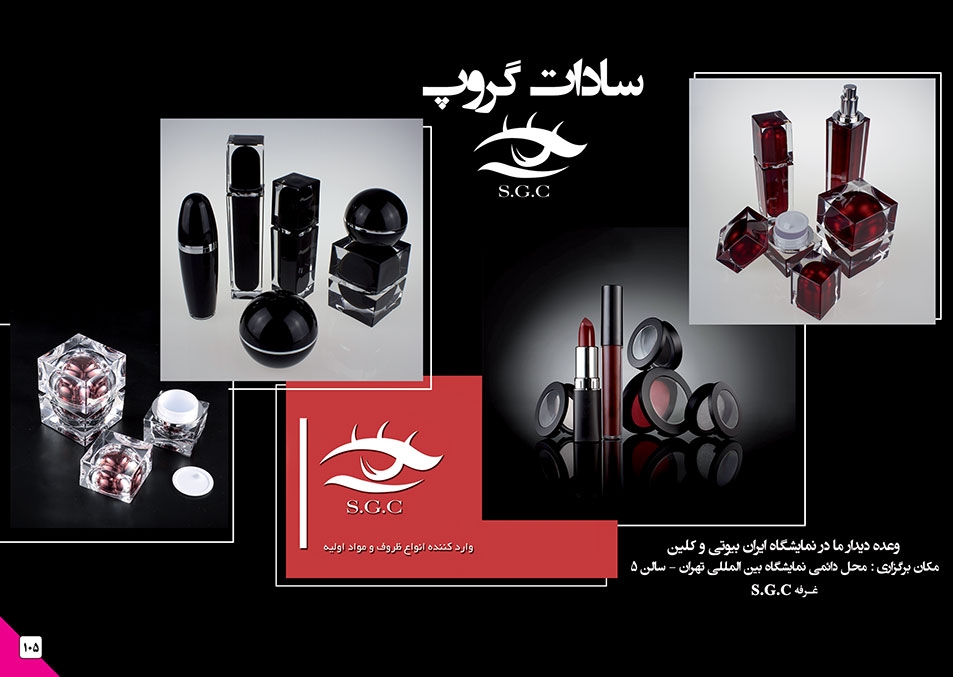
شرکت سادات گروپ کازمتیک واردکننده انواع ظروف و مواد اولیه آرایشی بهداشتی، عطر و ادکلن از کشورهای اروپایی، آسیایی با چاپ و سفارش دلخواه شما
S.G.C
منبع: مجله ایده

برای اطلاع از سرفصل های پکیج آموزشی، کلمه اسکین تراپی را با واتسپ به شماره 09101971690 بفرستید یا روی لینک اسکین تراپی کلیک کنید و اینترنتی خرید کنید
مطلب فوق را در شبکه های اجتماعی زیر با دوستانتان به اشتراک بگذارید
